

Identify beetles
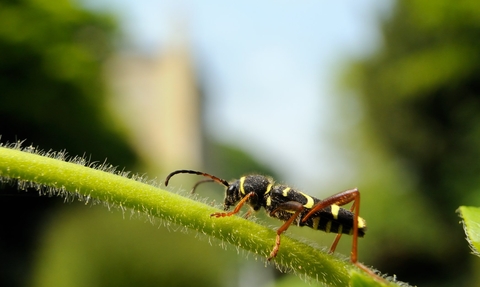
Nick Upton/2020VISION
How to identify beetles
What is a beetle.
Beetles are insects from the order Coleoptera — which means 'sheath-winged'. In most beetles, the front pair of wings has adapted to form tough, protective cases that lie across their back, giving them their armoured appearance. These wing cases (called elytra), protect the more delicate wings that are actually used for flight. When they're ready to take off, the wing cases pop up and the functional wings come out, ready to launch the beetle into the air. Not all beetles can fly, and some have really short wing cases that don't completely hide the abdomen.
Which beetles am I likely to see?
Beetles are one of the most diverse groups of animals on the planet, with over 400,000 different species across the world — there are over 4,000 species in the UK alone! Even without looking too hard, it's easy to stumble across beetles in almost any habitat. They sit on flowers, climb up trees, and even wander across paths. There are also plenty of large, or brightly coloured beetles to catch our attention, from the big and bulbous bloody-nosed beetle, to the bright red or yellow ladybirds.
We've picked out a few of the more recognisable beetles that you're likely to bump into, but first here are a couple of words from beetle biology that you might find helpful:
- Pronotum - the hard, plate-like structure covering the part of the body just behind the head
- Elytra (singular elytron) - the hardened wing cases that cover the rear body section of most beetles
Bloody-nosed beetle
When & where: April-June. Widespread in south and central England, on grassland, heathland, and hedgerows. Often seen plodding across paths.
Description: A large (up to 23 mm), shiny black beetle with a bluish sheen. The body is rounded, and the pronotum is wider at the front than the back. The antennae are distinctly bobbly.
The similar small bloody-nosed beetle only reaches around 11 mm long and has a more evenly rounded pronotum.
Bloody-nosed Beetle ©Bruce Shortland
Bloody-nosed beetle © Tom Hibbert
Bloody-nosed Beetle ©Philip Precey
Green tiger beetle
When & where: April-September. Across the UK on bare, sandy ground on heathland, grassland, dunes, and often brownfield sites.
Description: A large (up to 15mm) and distinctive metallic green beetle with yellowish spots on the wing cases, purple-bronze legs, and large, prominent eyes.
Green Tiger Beetle ©Philip Precey
Green tiger beetle © Ross Hoddinott/2020VISION
Green tiger beetle © Vaughn Matthews
Devil's coach horse
When & where: April-October. Widespread in a variety of habitats, including gardens. Largely nocturnal, hiding under logs and stones during the day.
Description: A long, slender black beetle with large jaws and short wing cases that don't cover the abdomen. When threatened, it curls its abdomen up in a scorpion-like posture.
Devil's coach horse ©Paul Richards
Devil's Coach Horse ©Russ Cribb
devil's coach horse by Alan Price
Harlequin ladybird
When & where: March-November. An introduced species that's now common across the UK. Often tries to enter buildings in autumn, looking for somewhere to spend the winter.
Description: A highly variable ladybird. Can be yellow, orange, red, or black, with 0-21 spots. The most commonly seen forms are orange with 15-21 black spots, or black with 2-4 orange or red spots. The pronotum is often white, with a large, black M-shaped mark. Larger than many similar ladybirds (over 5 mm), with reddish-brown legs.
Harlequin ladybird © Rob Bates
Roosting harlequin ladybirds © Philip Precey
Harlequin ladybird ©Paul Hobson
Harlequin Ladybird ©Amy Lewis
Harlequin Ladybird ©Rachel Scopes
7-spot ladybird
When & where: March-October. Widespread and common across the UK.
Description: One of our most familiar ladybirds, with seven small black spots spread symmetrically across its red back: three on each wing case, with the seventh at the front spread across both of them. It has black legs.
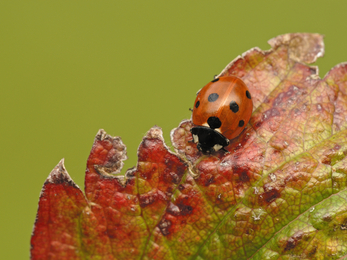
7-spot Ladybird ©Dawn Monrose
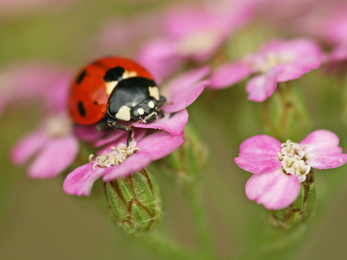
7-spot Ladybird ©Rachel Scopes
Swollen-thighed beetle
When & where: April-September. Meadows and grassy areas in Wales and the southern half of England. Often visits flowers on sunny days.
Description: A slender, metallic green beetle, with a gap between the two wing cases. Males have obviously swollen thighs.
Male swollen-thighed beetle © Tom Hibbert
Male swollen-thighed beetle © Chris Lawrence
Male swollen-thighed beetle © Jon Hawkins - Surrey Hills Photography
Male swollen-thighed beetle © Guy Edwardes/2020VISION
Wasp beetle
When & where: May-July. Widespread in England and Wales, rarer in Scotland. Found in woodlands and hedgerows, often visiting flowers.
Description: A black and yellow beetle that mimics the patterning of a wasp, with several yellow bands across the wing cases. It has long antennae (though relatively short for a longhorn beetle) that are reddish near the base and darker towards the tip. The legs are also reddish, with darker thighs.
Wasp beetle © Vaughn Matthews
Wasp Beetle ©Penny Frith
Wasp beetle © Les Binns
Black-and-yellow longhorn beetle
When & where: May-August. Widespread in England and Wales, reaching southwest Scotland. Found around woodland edges and hedgerows. Often visits flowers, especially umbellifers, brambles, and thistles.
Description: A distinctive black and yellow beetle, with long legs and very long antennae. The head and pronotum are black, the wing cases are yellow with black markings and taper towards the rear. The black markings vary, but usually appear as two complete black lines on the rear half, and two broken black lines on the front half.
Black-and-yellow longhorn beetle © Jon Hawkins - Surrey Hills Photography
Black-and-yellow longhorn beetle © Tom Hibbert
Black-and-yellow longhorn beetle © Tom Hibbert
Black-spotted longhorn beetle
When & where: April-August. Widespread in England, Wales, and Scotland. Found in woodland and wooded parks, often visiting flowers.
Description: A mottled yellowish-brown and black beetle. It has two large black spots on its wing cases, with a pale band either side of each spot. The antennae are relatively short for a longhorn beetle.
Black-spotted longhorn beetle © Brian Eversham
Black-spotted longhorn beetle © Tom Hibbert
Golden-bloomed grey longhorn beetle
When & where: April-August. Widespread in England, though scarcer in the north and absent from the southwest. Found in meadows and hedgerows, often sitting on umbellifer or thistle flowers.
Description: A large and distinctive beetle. Mostly a shining gold colour with black mottling. The antennae are incredibly long, with bands of black and bluish-grey.
Golden-bloomed grey longhorn beetle © Jon Hawkins - Surrey Hills Photography
Golden-bloomed grey longhorn beetle © Tom Hibbert
Golden-bloomed grey longhorn beetle © Jon Hawkins - Surrey Hills Photography
Stag beetle
When & where: May-August. Woods, parks and gardens in south-east England. Males can be seen flying at dusk.
Description: A huge, bulky beetle that can be 50-75 mm long. They have a broad black head and pronotum, and shiny, brownish wing cases - though these are darker in females. Males can be instantly recognised by their massive, reddish-brown antler-like jaws. Females have smaller jaws and resemble lesser stag beetles, but can be told apart by the shiny brown hue of their wing cases.
Stag Beetle ©Terry Whittaker/2020VISION
Female stag beetle © Paul Browning
Lesser Stag Beetle ©Margaret Holland
Lesser stag beetle
When & where: May-September. Woodland, parks and occasionally gardens, in England north to Yorkshire, and parts of Wales.
Description: A big black beetle that looks very similar to the larger female stag beetle, but only reaches lengths of 30 mm. Lesser stag beetles can be recognised by their matt black wing cases, which lack the shiny brown hue of the female stag beetle's.
Lesser stag beetle ©Wendy Carter
Lesser stag beetle © Margaret Holland
Lesser stag beetle © Tom Hibbert
Rose chafer
When & where: May-October. Woodland, parks and occasionally gardens. Scattered distribution across southern England and Wales, scarcer further north.
Description: A large, iridescent green beetle with short, creamy white streaks on the wing cases. There is a distinct V shape where the wing cases meet. The green can be coppery or have golden hues.
Rose Chafer ©Derek Moore
Rose chafer © Jon Hawkins - Surrey Hills Photography
Rose chafer © Tom Hibbert
Rosemary beetle
When & where: Can be seen all year, but often most common in May and June. Found on herbs, including rosemary, lavender and thyme.
Description: A small, shiny beetle with metallic green and purplish-red stripes along its back. The pronotum is mostly metallic green with some purplish-red markings. The legs are a pale reddish colour.
Rosemary beetle © Pete Richman
Rosemary beetle © Brian Eversham
Rosemary beetle © Tom Hibbert
Common red soldier beetle
When & where: June-August. Very common throughout the UK. Usually found on flowers, particularly umbellifers and thistles. Pairs are often found mating.
Description: A small, reddish-orange beetle. The wing cases are slightly brown or yellow-tinged, with black tips at the rear. The legs are mostly red, but are black at the end.
Common Red Soldier Beetle ©Philip Precey
Common red soldier beetle © Neil Aldridge
Red soldier beetle © Brian Eversham
Red soldier beetles © Brian Eversham
Cantharis rustica
When & where: May-August. Very common throughout Wales and southern and central England. Scarcer in northern England and Scotland. Usually found on flowers, particularly umbellifers and thistles.
Description: A fairly large black and red beetle. The wing cases are glossy black and the pronotum is red with a black heart-shaped mark in the centre. The legs are black with a variable amount of red at the base.
Soldier beetle, Cantharis rustica © Tom Hibbert
Cantharis rustica © Chris Lawrence
Red-headed cardinal beetle
When & where: April-July. Widespread in England and Wales, though more scarce in northern England. Found close to wooded areas, sometimes basking on large leaves or visiting flowers, particularly umbellifers.
Description: A large red beetle with black legs and antennae. The completely red wings cases and head help tell it apart from any similar species.
The black-headed cardinal beetle is similar, but can be recognised by its black head.
Red-headed Cardinal Beetle ©David Longshaw
Red-headed cardinal beetle © Amy Lewis
Red-headed cardinal beetle © Vaughn Matthews
Not a beetle!
The word bug is often used to describe any sort of insect, including beetles. But there is actually a group of insects known as the true bugs, from the order Hemiptera. Some of these species, such as shieldbugs, can sometimes be mistaken for beetles. One of the key differences is in the mouthparts - beetles have pincer-like mandibles, but bugs have a hardened snout called a rostrum. Like beetles, shieldbugs have hardened forewings, but only half of the wing is hardened, the rest is membranous. Their wings cross over each other when they're at rest, so they don't show the neat line between the wing cases that beetles do.
Hairy shieldbug © Chris Lawrence
©Rachel Scopes
Blue shieldbug © Vaughn Matthews
How you can help
As a charity we rely on memberships. They help us look after over 2,300 nature reserves and protect the animals that call them home.
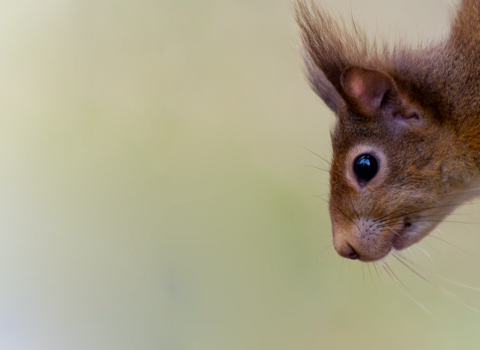
Bertie Gregory/2020VISION
Sign up to our e-news!
Get monthly newsletters packed with ways that you can help wildlife!
More about beetles
The brilliance of beetles
Steve Garland, chair of Lancashire Wildlife Trust and beetle expert, explores the world of these incredible, armoured insects.
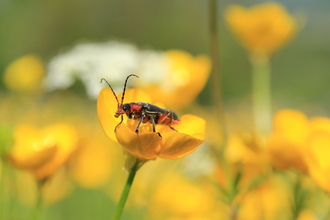
Gardeners urged to help beetles
Beetles are the unsung heroes of the garden and need our support urge the Royal Horticultural Society (RHS) and The Wildlife Trusts, as…
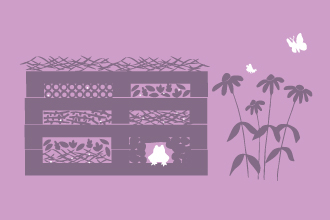
How to build a bug mansion
Build your own bug mansion and attract a multitude of creepy crawlies to your garden.
- Magazine Subscription Offer
- Newsletters
- Competitions
- Holiday ideas
- Wildlife stories
- Marine life
- Insects and invertebrates
- Trees and plants
- Experiences
- Historical figures
- Green living
- Food & recipes
- Foraging guides
- Outdoor skills
- Craft ideas
- Photography
- Latest issue
- Meet the team
- Countryfile TV guide
- Countryfile presenters
- Countryfile calendar
British beetle guide: where to see and how to identify these fascinating insects
From the striking rose chafer to the stag, beetles are a fascinating group of insects found widely throughout the UK. Here is our expert UK beetle species guide, which explains how to identify and best places to spot them.
Richard Jones
Beetles are one of the most diverse groups of insects in the world, and the UK is home to a wide variety of species. From the familiar ladybird to the more unusual stag beetle , there is something for everyone to enjoy.
This guide will introduce you to some of the most common and interesting beetles found in the UK. You will learn about their appearance, habitat, diet, and behaviour. You will also find out about the threats facing beetles and what you can do to help them.
So, whether you are a seasoned naturalist or simply curious about these fascinating creatures, this expert guide by entomologist and author Richard Jones, is for you.
Learn more about fascinating British species such as butterflies , bees and dragonflies . We've also gathered our favourite insect identification books which are handy to use when you're in the field.
How many beetle species are there in the UK?
With over 4,000 species in the British Isles, many of which are very small, beetles are often portrayed as being a ‘difficult’ group, the preserve of experts. However, there are plenty of beetle species that are either large, brightly coloured or easy to identify in the field or from photos, such as ladybirds, stag beetles, and longhorn beetles.
Around 40% of the UK's insects species are beetles. Around 1,000 of these live in woodlands and forests, and around 2,000 can be found in London – including the incredible stag beetle, which is the largest beetle in Britain. And did you know the world’s largest beetle measures over 15cm in length?
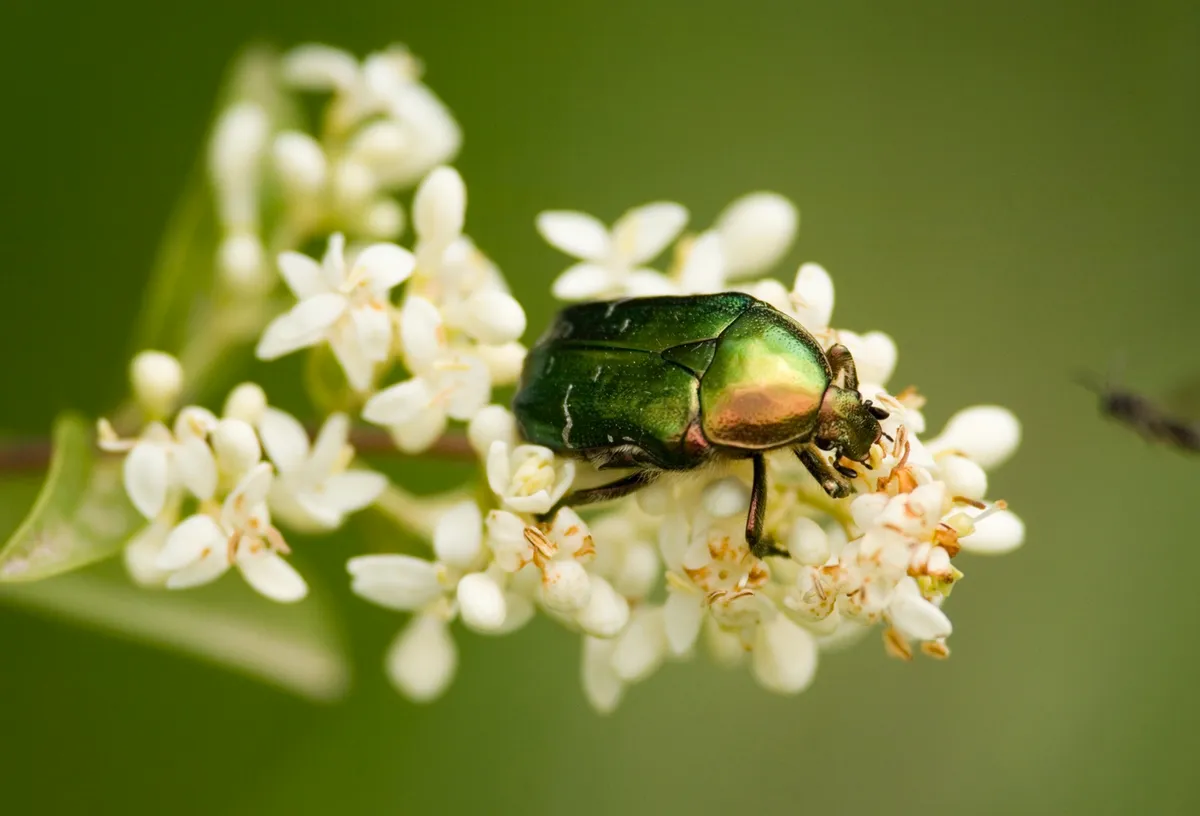
Confirmations can always be sought at the ' I spot nature ' identification site where your uploaded photos (of beetles, and indeed any organism) are regularly checked by experts and enthusiasts. You can also download the 'Seek' app from iNaturalist to identify plants and insects for free.
More beetlemania
- 6 amazing dung beetle facts
- How big are beetles?
- Where do beetles live? The different places beetles thrive
What are beetles?
Beetles (scientific name Coleoptera, meaning 'sheath-wing' in Greek) are an insect with two pairs of wings: one hardened outer set called an 'elytra' (like a 'shell'), which protects the more delicate flight wings housed underneath. They have three main sections to their bodies – a head, thorax and abdomen; six jointed legs; an exoskeleton and a pair of antennae.
What do beetles eat?
British beetle species have a varied diet. Some species, such as the lesser stag beetle like to eat rotting wood, while the orange and black sexton beetle, favour decaying animals to lay their larvae.
Meanwhile, the dor beetle eats faeces from animals. Many other species prefer the pollen and nectar from plants.
Discover more fascinating insect facts
- Britain’s largest insects: which insect can be crowned the UK's largest?
- Guide to British butterflies
- Britain's key insects pollinators
- Guide to Britain’s moths: species, identification and why they are important
- What are insects?
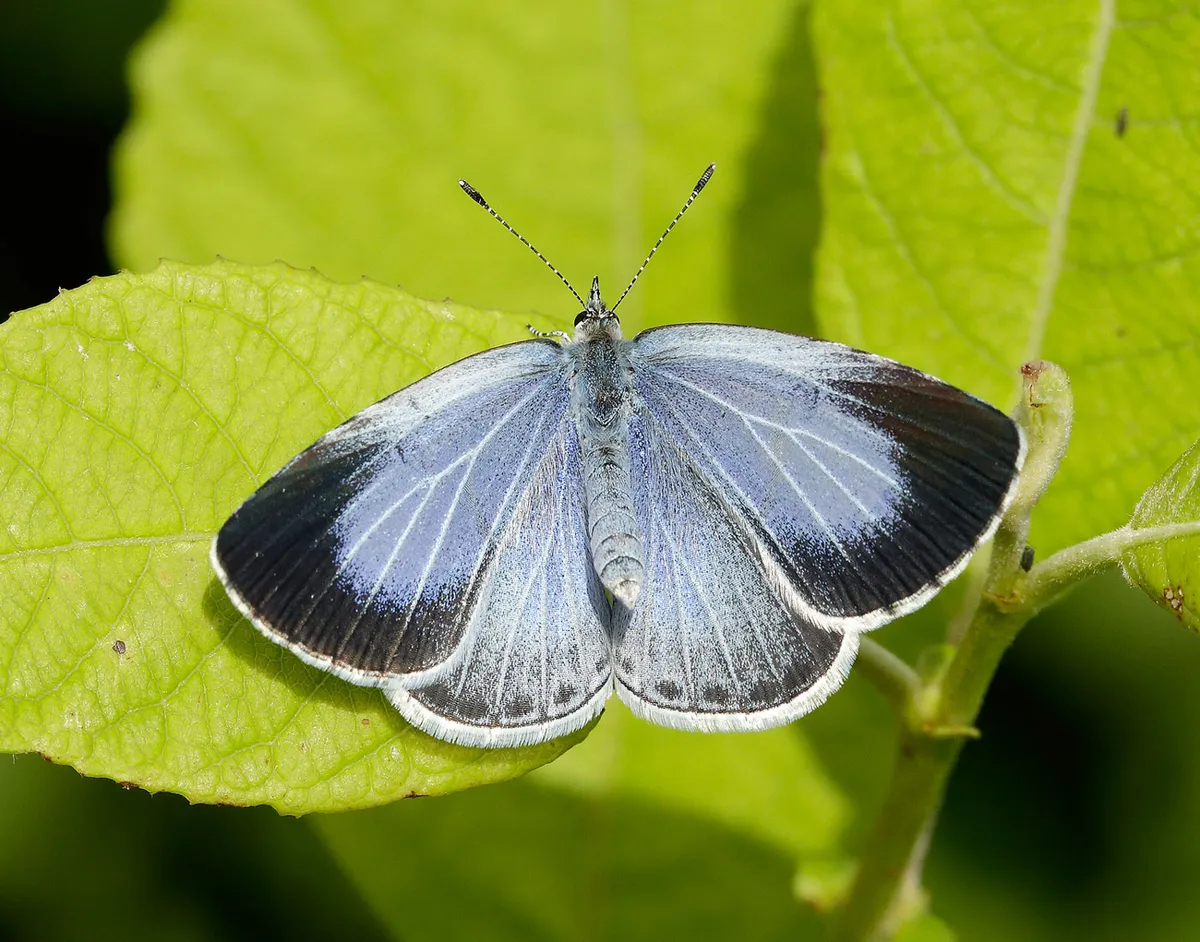
How to identify British beetle species
Green tiger beetle ( cicindela campestris ).
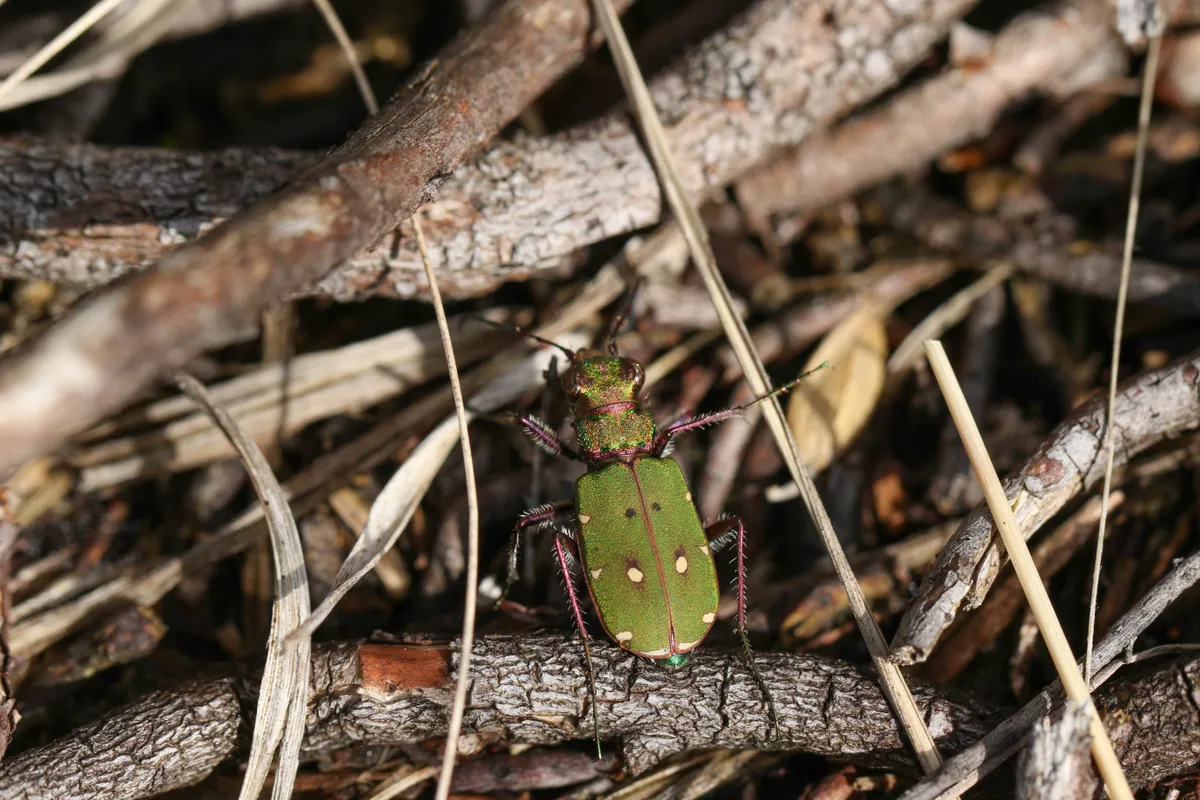
With long legs and sharp jaws, this fearsome predator takes short flying leaps to attack prey or escape. It is very active on patches of sparsely vegetated or bare sandy or chalky soil.
Cockchafer ( Melolontha melolontha )
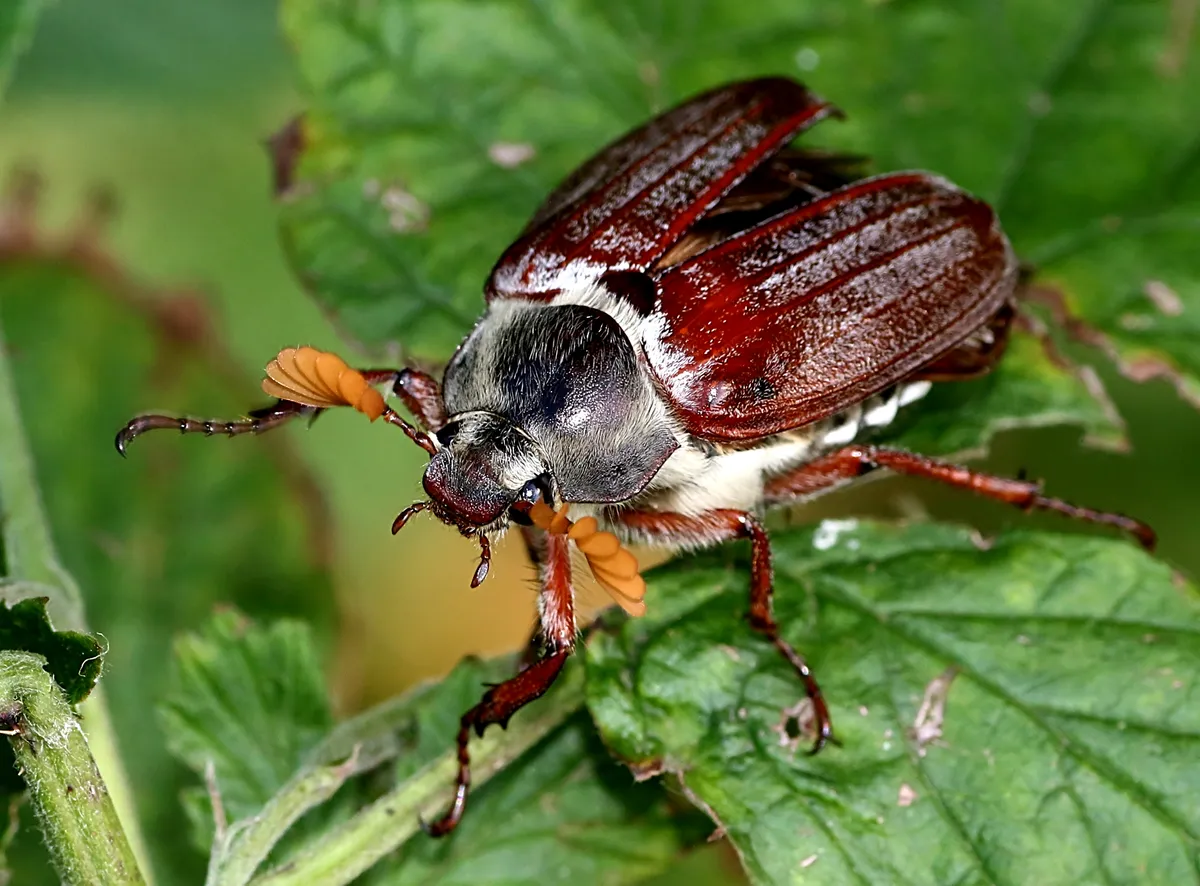
Mostly nocturnal, cockchafers are also called May-bugs for its appearance in spring. Old reports note clouds of cockchafers banging on to lit windows or street lamps. Larvae are fat, pale, C-shaped maggots in the soil, feeding on grass.
Rose chafer ( Cetonia aurata )
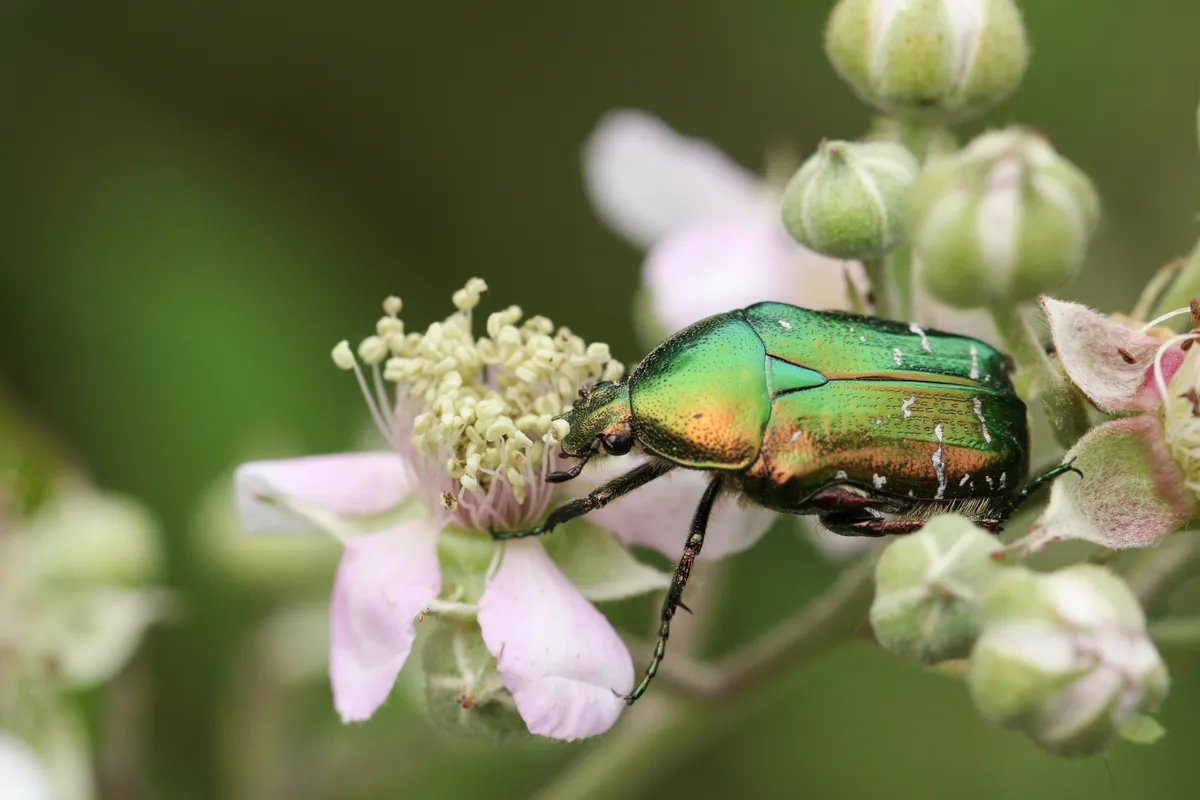
This living jewel is metallic green all over. Unlike most beetles, it flies with its wing-cases closed and has a special notch at the side to accommodate its membraneous flight wings. It often sits on flowers.
Twenty-two-spot ladybird ( Psyllobora vigintiduopunctata )
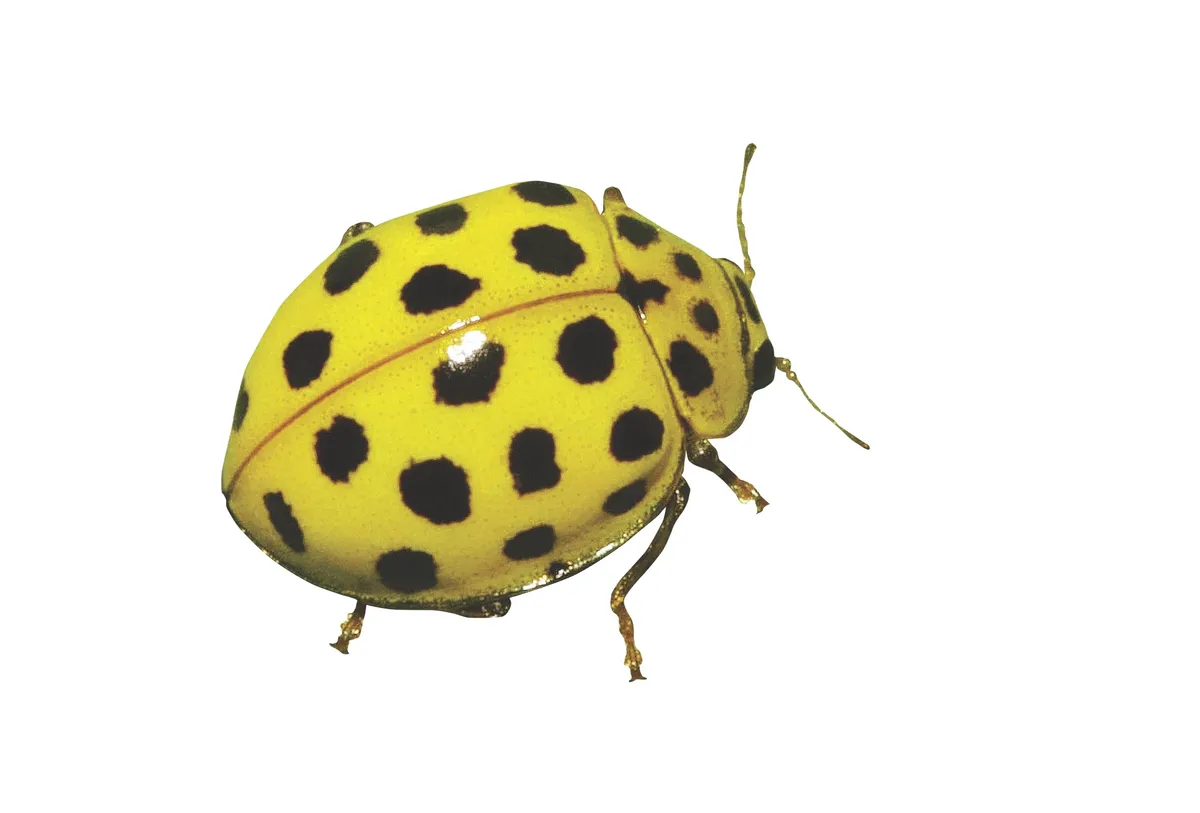
The brightest lemon-yellow of any British beetle, this always has 22 round jet-black spots on its cheerful wing cases. A mildew feeder, it grazes on mould and fungal hyphae.
Whirligig beetle ( Gyrinidae )
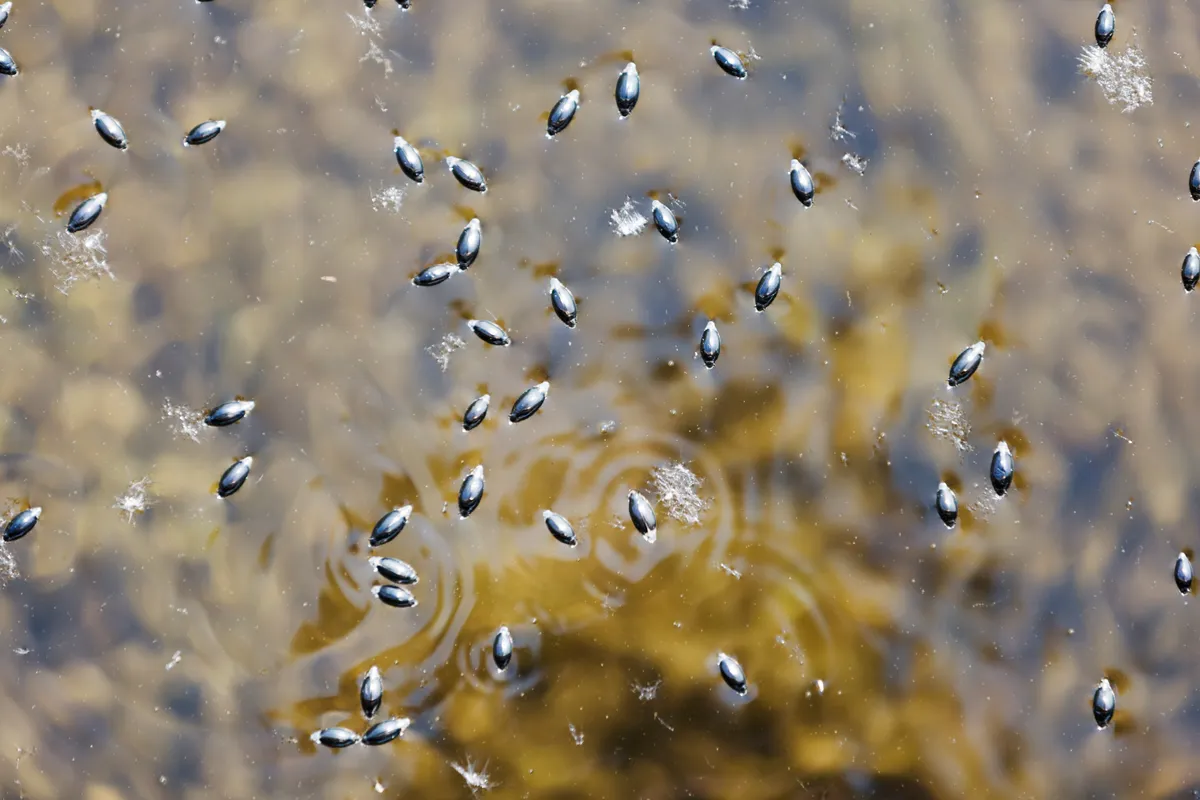
This small, shiny oval beetle is so named because it swims in tightly, sometimes frenzied circles on the surface of ponds and slow moving rivers and streams. Here it hunts small creatures that fall onto the water. It can also dive to catch prey.
Learn more about freshwater pond wildlife.
Violet ground beetle ( Carabus violaceus )

A large (3cm long), fast-moving and aggressive beetle with a powerful bite that hunts worms, small slugs and other invertebrates. It roves at night in woods, meadows and gardens and has a distinctive purple sheen to its carapace. If alarmed, it gives over a rank smell.
7-spot ladybird ( Coccinella septempunctata )

Our most familiar beetle and a nursery rhyme favourite with its bright red oval carapace with black spots. Still common, although declining. Its dark-grey larva have a reptilian appearance and, like adults, prey voraciously on aphids. Truly a gardener's friend.
Oil beetle ( Meloe )
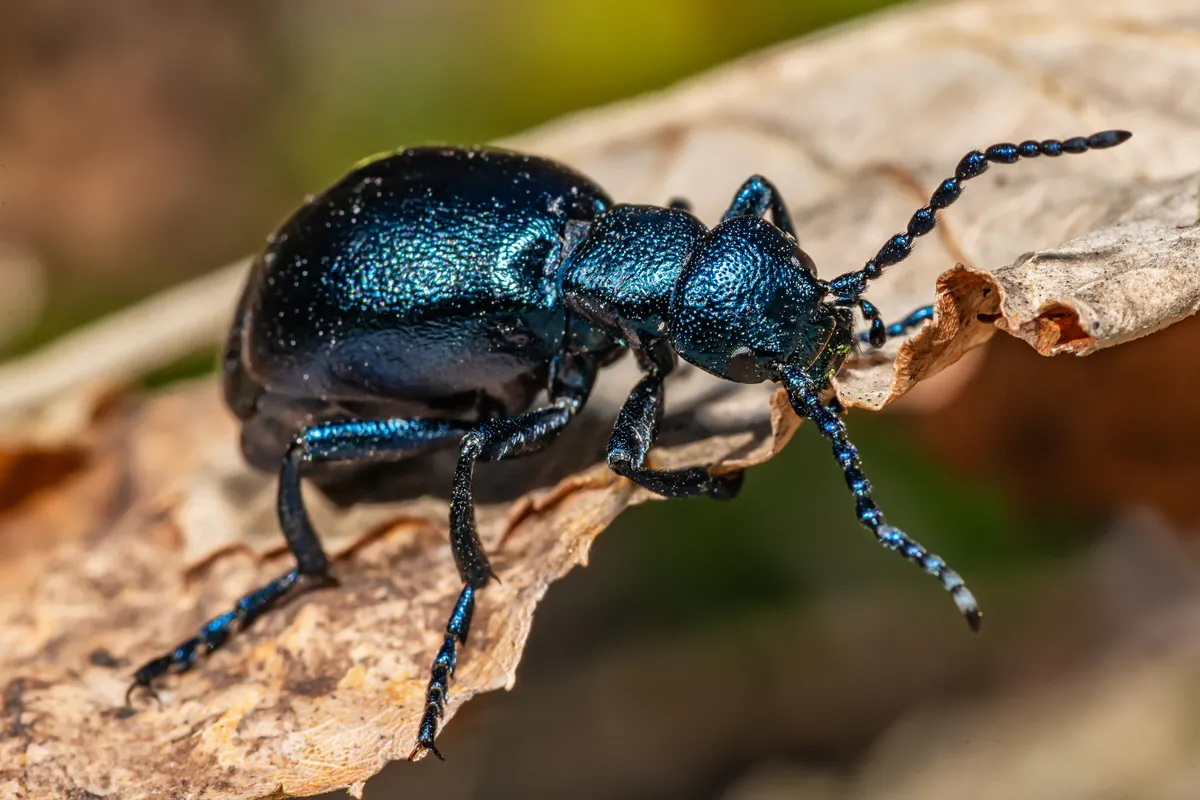
Up to 4cm long, these are hugely impressive insects with distinctively bulbous abdomens and are found commonly on meadow flowers, particularly celandines, in spring. There are five oil beetle species in the UK and they are named for their shiny, oily appearance. The larvae parasitise solitary mining bee nests.
Soldier beetle ( Cantharidae )

A raft of handsome species found on summer flowers (particularly thistles and umbellifers) and are fantastic pollinators. All have long, thin bodies. The red soldier is orange-red all over but with a black tip to its abdomen. Other species have black-grey heads and abdomens separated by red thoraxes.
Devil’s coach-horse ( Ocypus olens )
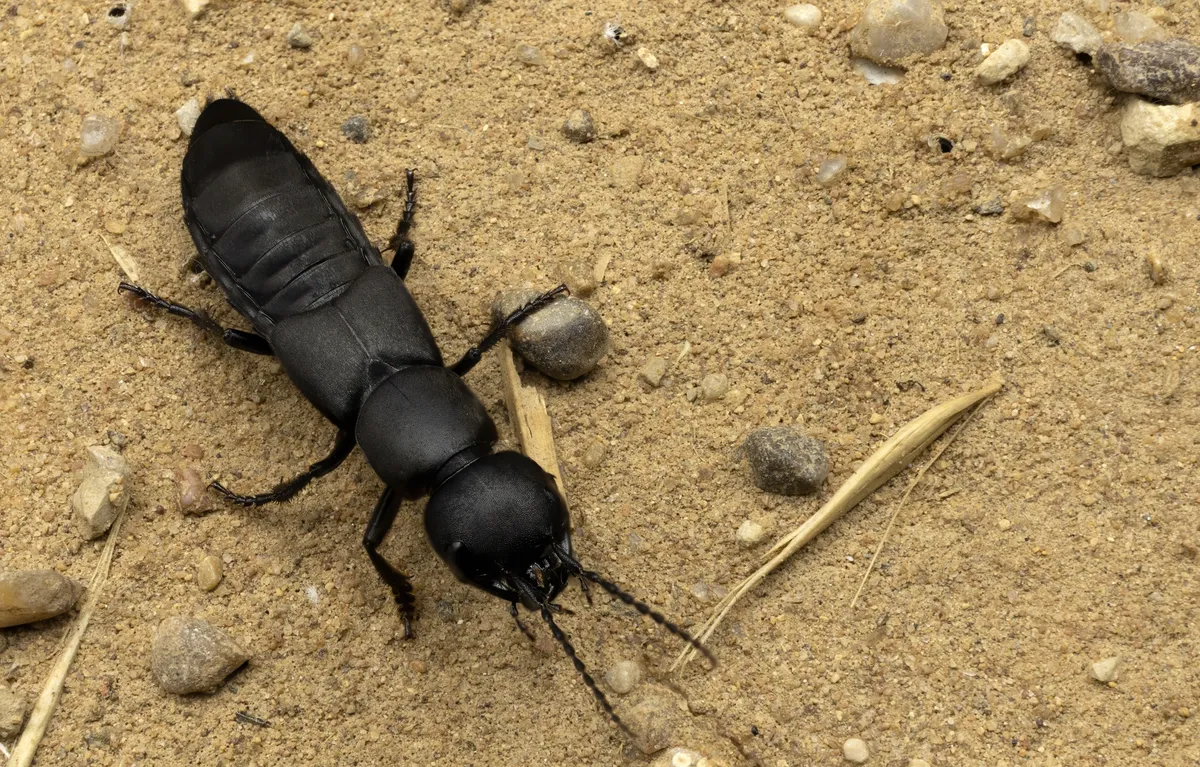
Britain’s largest rove beetle is a gothic monstrosity found under logs and stones. Its short wing-cases expose a flexible hind body – it will rear up and wave its large jaws menacingly, and it can nip.
More related content:
- Garden pond guide: how to look after your pond and wildlife to spot
- Guide to British trees: how to identify common tree species and where to find
- Guide to slugs and snails: how to identify common species and protect your plants

Red-headed cardinal beetle ( Pyrochroa serraticornis )
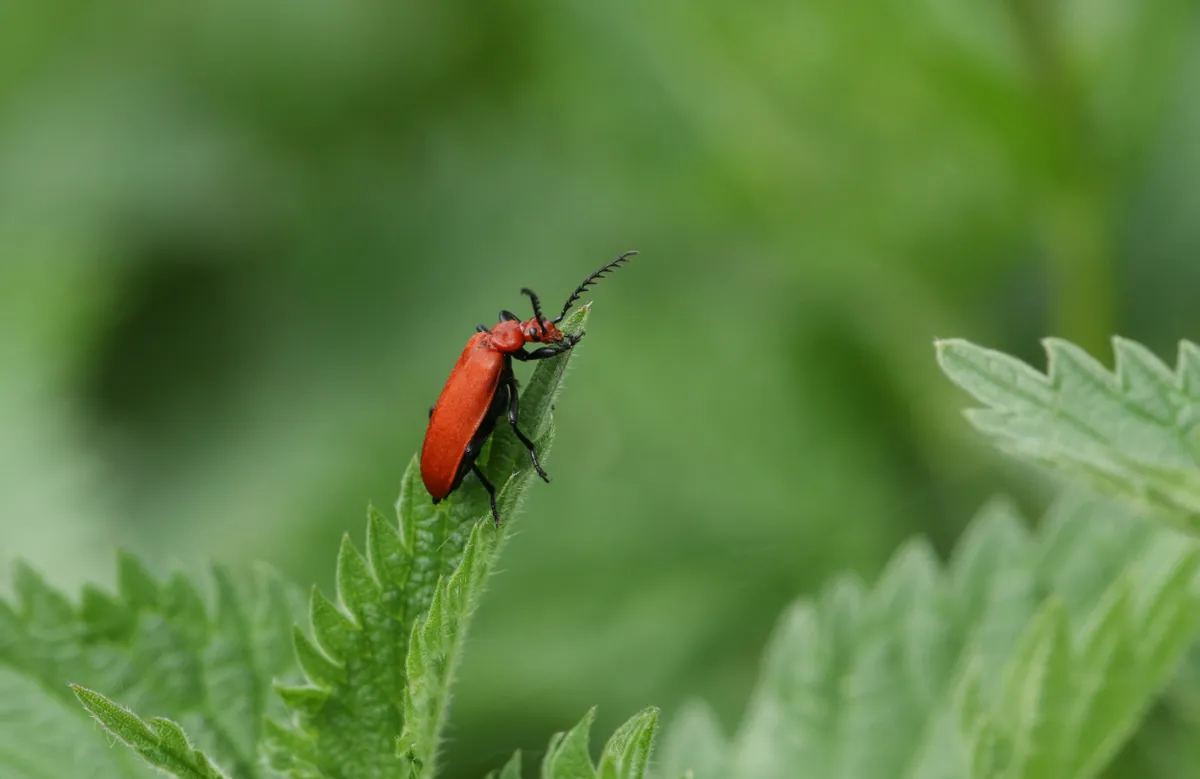
It is named for its papal colour scheme, which warns predators not to eat it as it contains poisons (it's harmless to pick up). Flat larvae, with two-pronged tail, feed under logs and bark.
Green tortoise beetle ( Cassidinae )
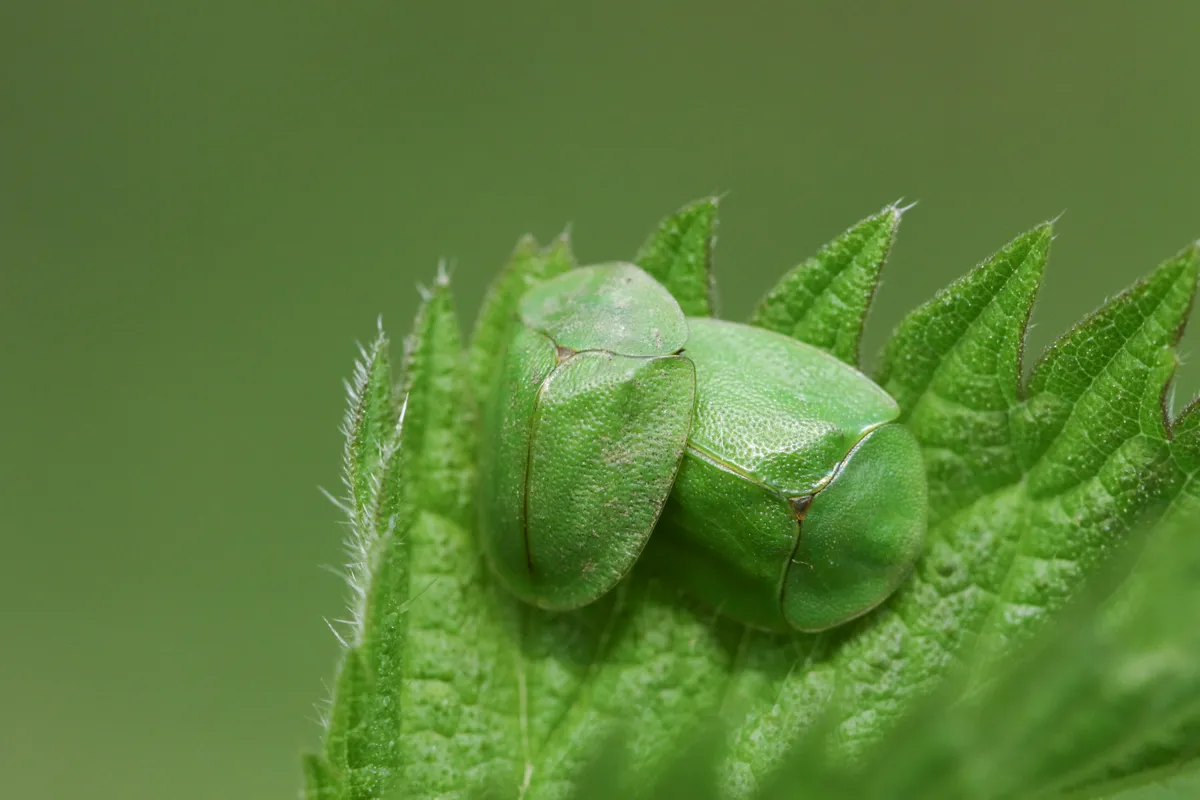
Flattened and flanged, it clamps down on to its water-mint food-plant leaf if disturbed. The larvae keep hold of their dry excrement and moulted skins to make a predator-avoiding blob-parasol on their tail end.
Wasp beetle ( Clytus arietis )
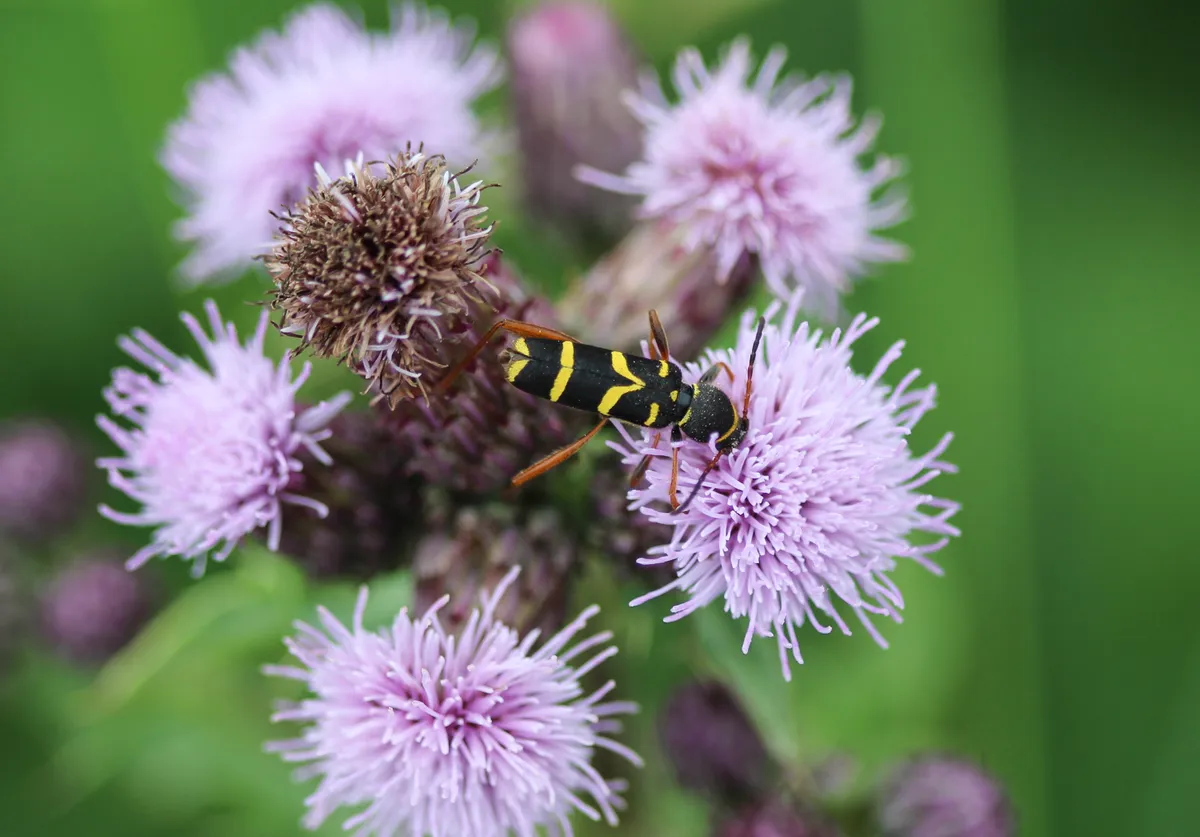
This has deceptively wasp -like colours, plus striking red legs, jerky movements and hawking flight. Larvae feed in dead wood; adults are often seen in sunshine running on stacked logs, or buzzing over bramble flowers.
Stag beetle ( Lucanus cervus )

The UK’s largest beetle spends most of its life out of view. The larva feeds on dead wood below ground for five years before emerging as an adult. Only the male possesses the ‘antlers’, which are infact enlarged jaws. The stag beetle has declined due to a loss of dead wood habitat.
Why not join the great stag hunt and help protect this precious beetle?
Bloody nosed beetle ( Timarcha tenebricosa )
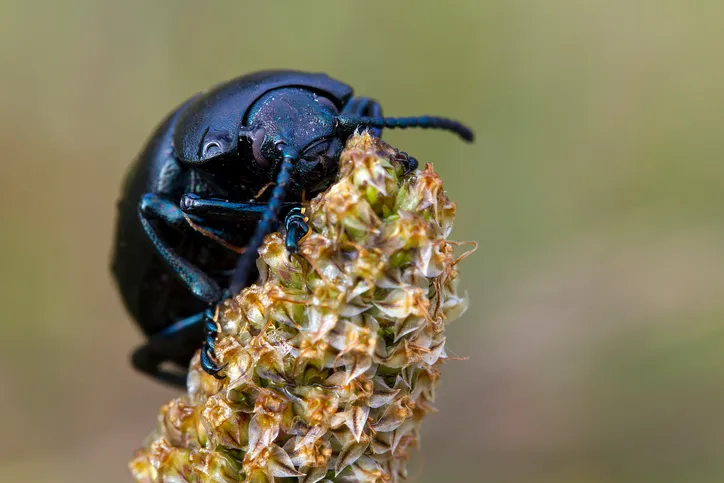
This handsome black beetle is flightless and can be seen walking along the ground or in low vegetation in April. It’s often found in coastal areas and on grasslands in the south of the UK. The beetle’s name comes from its defence strategy of exuding bright red fluid from its mouth when threatened.
Dor beetle ( Geotrupes stercorarius )
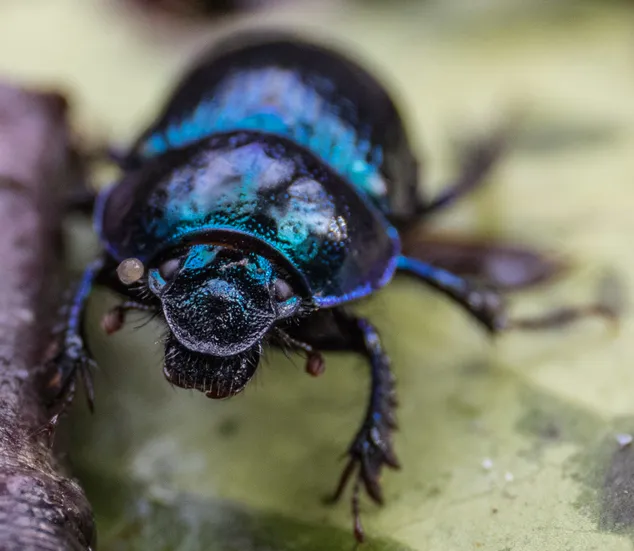
This large beetle has a distinctive black domed body that shines blue or violet in the light. It feeds on dung and is found in grasslands and woodlands grazed by sheep or cattle. The endless munching of dor beetles saves from being knee deep in animal dung.
Sexton beetle ( Nicrophorus )

This distinctive beetle has a black and orange patterning on its wing cases. It performs an important service in burying and recycling carrion (usually small mammals and birds). Its antennae are packed full of receptors enabling it to smell a dead animal up to a mile away.
Harlequin ladybird ( Harmonia axyridis )

The most invasive ladybird, the harlequin arrived in Britain in 2004 and has spread rapidly. This beetle has the potential to jeopardise many of our native ladybird species through competing for food or eating their larvae - along with scale insects, eggs and larvae of butterflies and moths, other ladybirds and even their own larvae (cannibalism). It is very variable in appearance and so well established that controlling their numbers would make little difference to their presence overall. They often overwinter in large groups on the insides of buildings.
Great diving beetle ( Dytiscus marginalis )
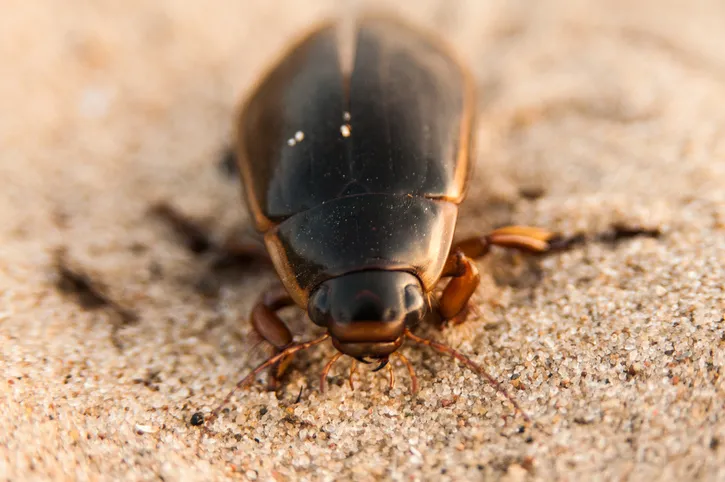
Both larvae and adults are voracious predators of tadpoles, aquatic insect larvae and small fish. The larvae have a scorpion-like appearance and live underwater for two years before transforming into the adult beetle. The 3cm long adults come to the surface regular to replenish their air supply by sticking their abdomen’s out of the water.
Thick legged flower beetle ( Oedemeridae )
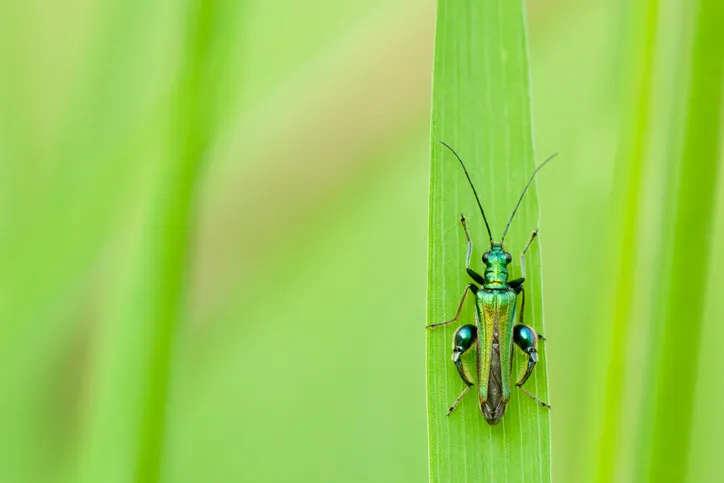
This spectacular shiny metallic green beetle is most often seen on flowers such as daisy, cow parsley and hawthorn blossom. Only the male has the thickened ‘thighs’ that give the beetle its name; it uses them to impress females. The larvae live in hollow plant stems.
Glow worm ( Lampyris noctiluca )

Despite their name, glow worms are actually beetles rather than worms and it is only the females that glow. She does this to attract a male. Female glow worms have no wings so cannot easily move around to find a mate. Instead they climb up grass stems and switch on their lights. The glowing acts as beacon to the males who have excellent sight and spend their limited time flying around looking for females. Once they have mated, females turn out their lights, use all of the energy they have left to lay 50 to 100 eggs and then die.
Both sexes only live for two or three weeks as adults, so they can’t let a bit of rain get in the way of the need to reproduce.
In the UK, glowing females can be seen from May to September, however the main glow worm season is late June/July. They are mostly found on edge habitats of unimproved grassland, as these contain longish grass that the females can climb up and are usually open enough to give the males a good view.
How to make a bug hotel
Whether you have a large space, or just a windowbox, you can make a bug hotel that not only provides sanctuary for a host of fascinating creatures but also allows you to get close to them.
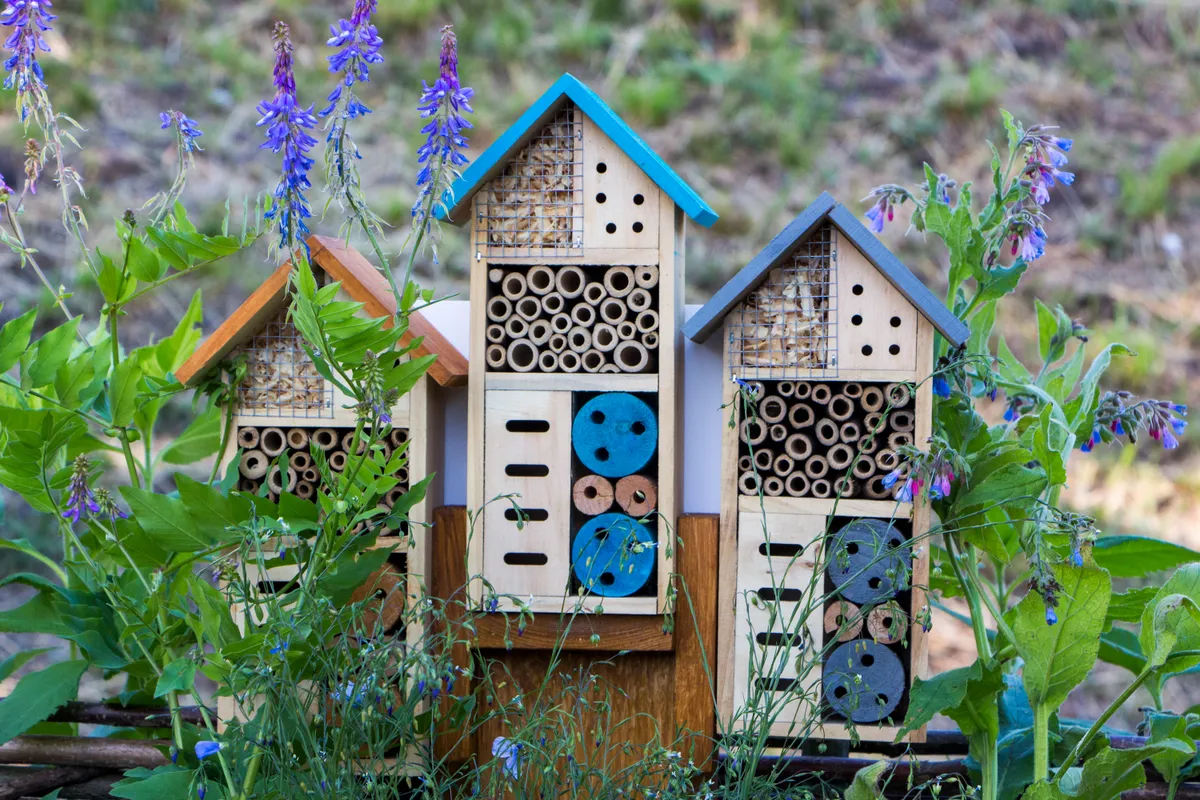
Share this article
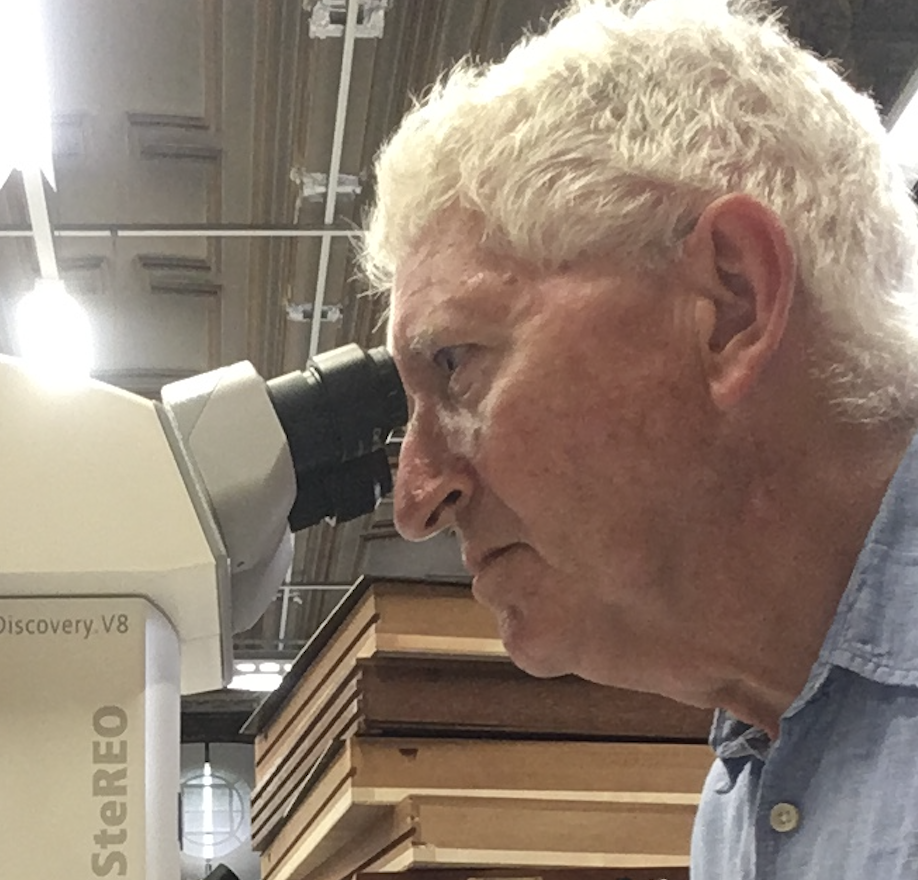
Entomologist

- Terms & Conditions
- Privacy Policy
- Cookies Policy
- Code of conduct
- Manage preferences
e-mail address

Guide to families
For a simple picture guide to the British families click HERE .
With more than 4000 species in about 1300 genera and nearly 100 families our fauna can be very difficult for the beginner to comprehend, especially so because of the way evolution works, which means that species from distantly-related families may look superficially similar because of morphological convergence, and similarly species within a family may look very different because of divergence. In such cases the answers lie in the fine detail. The majority of our species are included within a dozen or so large and distinctive families and so there will be plenty of stuff to keep the beginner occupied but unusual specimens will soon appear that will be more difficult to assign, and this is the point of what follows. Most of this page is devoted to assigning specimens to their correct families but the method we use is intended to be simple and user-friendly; it relies heavily on pictures (a resource that hasn’t always been available in the past) because visual recognition is what our human brains are very good at, but in each case we include a few simple notes of guidance which should be taken very seriously as they are chosen to overcome some of the problems of convergence and divergence.
It should be realized from the beginning that a basic familiarity with the terminology of beetle morphology is absolutely essential and we have tried to keep this simple. For the purpose of identification, where a critical visual awareness is the most important aspect (at least to the family level), this is all that is required and to facilitate this we have included a few diagrams that will provide all that is needed to use this page. Insect morphology is a vast and daunting subject that is mostly irrelevant to the study of beetles at this level but it really should be understood that in order to understand beetle evolution it is vital to understand this in fine detail- see the notes at the end of this article (actually I believe that the only way to really understand beetle evolution is by studying their molecular biology but so many people disagree with this that it will not be mentioned again, at least not here). The obvious step is to make sure that sufficient pictures are available to make the user of a guide to families confident that they have not mistaken something for something else. In truth this cannot be done without picturing at least all the genera, but the number of pictures can be drastically reduced by including a few words of guidance, and this is how our rather unorthodox guide to families will work.

Basic beetle morphology (Joy, 1932)
A close look at the pictures will often suffice, the comments should help, and the family links will give plenty of examples and advice. In most cases the following list can be inspected very quickly as many of the species included are so very distinctive, this should be at least as quick as using a key and should provide a confident elimination or match. Great care should be taken to measure the length of a specimen as this can sometimes eliminate groups of families. At this point it should be mentioned that experienced coleopterists know what features to look for, they also have a very critical eye for detail and the ability to assess things like the number of tarsal segments when these might seem confusing, these things cannot be understood without a good deal of experience and so those attempting to place specimens for the first time should be aware that a very critical eye needs to be developed, after a while many features and groups will be instinctively ignored because that’s what experience allows, but at first pay critical attention to any features mentioned. Comments in square brackets can be ignored [they are mostly for the pedantic] but may provide some insight to our fauna. Another aspect of identification must be mentioned and it is something that all experienced coleopterists understand, information about the origin of a specimen can greatly facilitate identification, if it was found in dung or at sap or on a particular plant this can suggest a species or group of species, and when sampling for a particular species this can dictate which trapping method to use or which plants to look at. Such things are for the experienced beetler and are only mentioned briefly below, on the other hand each family is linked to a page that should provide an abundance of such information as well as a much wider range of photographs of named species, in fact the majority of our species are featured and so with a little searching this site should get most specimens to at least the generic level.
MYXOPHAGA
Sphaeriusidae.
Minute Bog Beetles
Hemispherical, dark brown or black.
Antennae 11-segmented with a 3-segmented club.
Tarsal formula 3-3-3
Very rare, wetland margins.

Highly modified legs, reduced antennae and horizontally-divided eyes - nothing else remotely similar.
Tarsal formula 5-5-5

Crawling Water Beetles
Short filiform antennae, punctured elytral striae. Legs long and slender.
[Greatly expanded hind coxal plates]
Tarsal formula 5-5-5

Burrowing Water Beetles
Similar to Dytiscidae but the ventral surface is flat and some middle antennal segments are enlarged.
Elytra with large punctures, especially in the apical half.
[Hind coxae elevated medially.]

Hygrobiidae
Screech Beetles
Large and prominent eyes. Body very convex ventrally.
Tibiae with long apical spurs.

Diving Beetles
120 species approx.
Shape varies from broadly-oval to elongate-oval but always more-or-less boat-shaped, convex above and below.
Eyes at most only moderately convex, antennae filiform.
Aquatic, but many species attracted to light.

Ground Beetles
360 species approx.
At least some sensory setae on the body.
Antennae filiform.
Some colourful and/or metallic species.
[Prosternum with distinct notopleural sutures, hind coxae dividing the first visible sternite and not expanded laterally to meet the elytral epipleura, hind trochanters extending some way along the hind margin of the femora.]
Tarsal formula 5-5-5, rarely with bilobed segments.
Most habitats, rarely aquatic.

HYDROPHILOIDEA
Helophoridae.
Grooved Water Scavenger Beetles
Maxillary palps as long as antennae. Pronotum with longitudinal grooves, the innermost of which are sinuate or kinked about the middle.
Elytra with punctured striae, sometimes with longitudinal ridges.
Tarsal formula 5-5-5.
Mostly aquatic, some terrestrial species.

Georissidae
Minute Mud Beetles
Unique appearance. Head hidden from above, 9-segmented antennae with a pubescent 3-segmented club.
Large elytral punctures.
Outer margin of front tibiae angled.
Tarsal formula 4-4-4
Wetland margins.

Hydrochidae
Hydrochid Beetles
Eyes convex and very prominent, no longitudinal grooves to the pronotum, elytra with punctured striae.
Palps not greatly longer than the antennae, antennal club 3-segmented.
Aquatic and wetland margins.

Spercheidae
Filter-Feeding Water Beetles
Anterior margin of head emarginate. Very transverse pronotum. Palps longer than the antennae. Tibiae without long apical spurs.
Thought to be extinct in the UK.

Hydrophilidae
Water Scavenger Beetles
Elongate - oval and continuous in outline, convex above and flat below. Antennae inserted under the side of the head, almost always 9-segmented, club with 3 segments. Palps longer than the antennae (or very nearly so in some smaller species).
Tarsal formula usually 5-5-5; a few aquatic species are dimorphic, the males having 4-segmented front tarsi.
Aquatic, dung and compost, regularly at light.

Sphaeritidae
False Clown Beetles
Antennae not geniculate, with a 3-segmented club, all the segments clearly visible. Front tibiae with fine spines but without teeth and lacking tarsal grooves. Elytra leaving one abdominal tergite exposed, each with nine distinct rows of punctures.
Northern conifer forests.

Clown Beetles
0.8-11.0 mm
Antennae geniculate and clubbed. Front tibiae with tarsal grooves and usually dentate externally, elytra usually leaving two abdominal tergites exposed. Elytra very variable but never with nine rows of punctures.
Most genera are distinctive but experience will be needed with some of the small specimens, all of which are pictured on the family page.
Carrion, dung, decaying wood and vegetation.

STAPHYLINOIDEA
Hydraenidae.
Moss Beetles
Palps at least as long as the antennae, in most cases very much longer. Antennal club 5-segmented.
Tarsal formula 5-5-5, often appearing 4-segmented.

Feather-Winged Beetles
Tiny species, antennae distinctive; one or (usually) two large basal segments, others with long fine setae, club long and loose, insertions separated by at least the length of the two basal segments.
Tarsal formula variable, 2- or 3-segmented.
Decaying wood and vegetation.

Fungus Beetles
Most are elongate - oval and discontinuous in outline, some have a distinct occipital ridge, in many the base of the elytra is slightly narrower than the pronotal base. Most have a distinctive antennal club, five-segmented with the second segment smaller than the first and third (some Cucujidae also have this form of antennal club but are otherwise very different.)
Agathidium have a normal three segmented club but the species are globose and distinctive, Colon have a four-segmented club but are otherwise distinctive, Choleva and Catopidius have almost filiform antennae but the occipital ridge is obvious, Parabathyscia and Leptinus are eyeless, and Platypsyllus is uniquely weird.
Tarsal formula variable, 3-3-3 to 5-5-5.
Carrion and decaying vegetation.

Carrion Beetles
Either 12-30mm with elytra truncate, exposing the abdominal apex (Nicrophorinae) OR 9-17mm, head very narrow compared with the pronotum, elytra without punctured striae and front tibiae characteristic (Silphinae).
Carrion and decaying fungi etc., often at light.

Staphylinidae
Rove Beetles
1100 species approx.
Most are elongate and have short elytra which leave the abdomen substantially exposed, Scydmaeninae, and to a lesser degree Scaphidiinae, are the exceptions but they are otherwise very distinctive.
Most morphological features vary between and within subfamilies but the various forms will soon become familiar.
Certain Omaliinae have two ocelli and in Metopsiinae there is a single ocellus.
Pselaphinae have clubbed antennae and some have hugely-developed palps.
In most scydmaeninae the elytra cover the abdomen, they are small, at most 2.1 mm, and generally distinct; all have 5-segmented tarsi, all coxae are distinctly separated and most have small pits along the base of the pronotum and a small terminal maxillary palpomere.
Tarsi various but never pseudotetramerous on all legs.
All habitats, many on wetland margins but no true aquatic species.

SCARABAEOIDEA
Geotrupidae.
Dor Beetles
Very distinctive; mandibles projecting, eyes divided by a horizontal bar, antennae 11-segmented. Elytra very convex and covering abdomen.
Males of some species have horns.
Dung pasture and woodland, often at light.

Skin Beetles
3 species
Antennae 10-segmented with a 3-segmented, internally-expanded club. Pronotal and elytral sculpture distinctive. mm
5 visible sternites, epipleura wide to elytral apex.
Bird nests, bones and carrion, sometimes at light.

Stag Beetles
Antennae geniculate with a loose lamellate club. Dorsal surface glabrous. Five visible abdominal sternites.
Sexually dimorphic, all very distinctive.
Decaying wood, often at light.

Scarabaeidae
Scarab Beetles
Antennae 9- or 10- segmented with a tight lamellate club expanded internally. Six visible abdominal sternites.
Very variable.
Dung, roots, flowers, decaying organic matter, often at light.

Eucinetidae
Plate-Thighed Beetles
Elongate-oval, broadest in front of the middle and continuous in outline, pronotum broadest across the base and rounded anteriorly, elytra striate.
[The tarsi will separate this species from superficially-similar melandryids etc, and the form of the pronotum from any elateroid group.]
Tarsal formula 5-5-5, all segments obvious, none bilobed.
Fungi, adults at flowers.

Fringe-Winged Beetles
Very convex, head strongly converging before and behind the eyes. Antennae 10-segmented with a 2-segmented club.
Tarsal formula 4-4-4, without bilobed segments.
Among decaying plant material.

Marsh Beetles
Soft-bodied, elongate-oval, pubescent, delicate filiform or weakly serrate antennae, pronotum very transverse, elytra without striae.
Only Scirtes is atypical - expanded hind femora and very long hind tibial spurs.
Tarsal formula 5-5-5, usually with the fourth segment bilobed.
Mostly wetlands, damp wood and tree hollows.

DASCILLOIDEA
Dascillidae.
Orchid Beetles
1 species
Entirely brown and finely pubescent. Long filiform antenna. Pronotum transverse, sinuate across the base. Elytra without striae.
Tarsal formula 5-5-5, with extensively bilobed segments.

BUPRESTOIDEA
Buprestidae.
Jewel Beetles
Head transverse with very large eyes, most species elongate and metallic. First antennal segment about as long as the second.
Woodland or shrubby vegetation.

Pill Beetles
Continuous in outline, convex above and (less so) below. Antennae clubbed or gradually thickened, not geniculate. Elytra completely cover the abdomen. Legs flattened, tibiae with tarsal grooves. Legs retract tightly under the body.
Prosternal process reaches deeply into the mesosternum, middle coxae widely separated
Tarsal formula variable, 4-4-4 or 5-5-5.
Terrestrial, most habitats.

Riffle Beetles
Legs, and especially the tarsi, very elongate, the terminal tarsal segment long and thickened apically. Antennae usually filiform, palps much shorter than antennae – but see Macronychus . Elytra covering the abdomen, with striae and sometimes also longitudinal ridges.
Aquatic and wetlands.

Long-toed Water Beetles
Long-oval, entirely pale to dark brown. Antennae very short and highly modified, legs long and slender

Limnichidae
Minute Marsh-loving Beetles
Short pubescence forming wavy patterns, without elytral striae, antennae distinct; segments 9 and 10 quadrate or slightly transverse, segment 11 enlarged.

Heteroceridae
Mud-loving Beetles
Long-oval, discontinuous in outline, elytra patterned. Antennae short and highly modified, external margin of front tibiae with long teeth or spines.
Tarsal formula 4-4-4.

Psephenidae
Water Penny Beetles
Flattened and almost circular, antennae filiform or weakly serrate, elytra with strongly impressed and weakly punctured striae.
Wetland margins, permanently damp grassland and woodland.

Ptilodactylidae
Toe-winged Beetles
Eyes large and strongly convex, male antennae pectinate, female antennae weakly serrate, pronotum produced over the head, elytra with incomplete punctured striae.
Tarsal formula 5-5-5, third segment strongly lobed but narrow.

ELATEROIDEA
False Click Beetles
Long-oval species, narrowed anteriorly and posteriorly, Melasis is the only exception. Labrum not visible from above, second antennomere inserted eccentrically on the basal segment.
Decaying wood.

Throscid Beetle
Long-oval species, narrowed anteriorly and posteriorly, entirely brown, pubescent, eyes notched anteriorly, antennae clubbed.
Mostly woodland but may be swept or netted in many situations.

Click Beetles
1.5-21.0 mm
Long-oval species, narrowed anteriorly and posteriorly, colour very variable. Labrum visible from above, second antennomere inserted concentrically on the basal segment. Most with produced posterior pronotal angles and all with striate elytra.
Most habitats including wetland margins but never aquatic.

Net-winged Beetles
Head small and transverse. Ronotum broadest across the base. Elytra red or orange with distinct sculpture of longitudinal and transverse ridges.
Tarsal formula 5-5-5, with some segments bilobed.
Decaying wood and surrounding vegetation.

All stages glow to some extent, adults brightly so. Head covered by pronotum, sexually dimorphic, all readily identified from pictures.
Grassland and woodland pathways.

Cantharidae
Soldier Beetles
Elongate, flattened and soft-bodied, usually colourful. Long filiform antennae, convex and prominent eyes. Very distinctive; even the small and obscure species are soon recognized as cantharids.
Tarsal formula 5-5-5, with some bilobed segments.
Most habitats, especially open areas with lots of flowers.

DERODONTOIDEA
Derodontidae.
Tooth-necked Fungus Beetles
With a small ocellus beside each eye. Antennae with a loose 3-segmented club, pronotum and elytra strongly punctured.
Tarsal formula 5-5-5, three basal segments strongly lobed.
On conifer foliage especially pine.

BOSTRICHOIDEA
Dermestidae.
Larder Beetles
Very variable but the combination of clubbed antennae (sometimes highly modified) and very strongly sinuate pronotal base will place most species, all are distinctive and can be identified to genus by comparing with pictures. [Head with a dorsal ocellus, if not the underside with dense silky pubescence.]
Our two oddities are Thorictodes heydeni and Thylodrias contractus .
Wild and artificial habitats, sometimes indoors.

Bostrichidae
False Powderpost Beetles
Elongate, parallel-sided species. Head hypognathous. Elytra completely covering the abdomen. Antennae widely separated, with a 2- ( Lyctus ) or 3-segmented club.
Among decaying wood.

Spiderweb Beetles
To the generic level all are very distinctive, many have modified antennae, either pectinate, serrate or with the last three segments modified, and in most species they are closely approximated.
Mostly woodland, often indoors.

LYMEXYLOIDEA
Lymexylidae.
Timberworm Beetles
Highly modified palps in male. Females superficially like cantharids but are more elongate, have shorter antennae and lack lobed tarsal segments.
Woodland and parkland.

Phloiophilidae
Distinctive colour and pattern. Pubescent and randomly punctured. Antennae 11-segmented with a long 3-segmented club.
Tarsal formula 5-5-5, segments without lobes.

Trogossitidae
Bark-Gnawing Beetles
Very variable but all species very distinctive and easily recognized among our fauna. Elytra continuously rounded apically and covering the abdomen. Antennae 11-segmented, clubber or gradually thickened.
Tarsal formula 5-5-5 4-4-5, never pseudotetramerous, terminal segment usually as long as the others combined.
Woodland or artificial conditions.

Thanerocleridae
Elongate and randomly punctured, the clubbed antennae, large head and shield-shaped pronotum are distinctive.
Tarsal formula 5-5-5, basal segments of front tarsi bilobed.
Stored product pest, very infrequent in the UK.

Checkered Beetles
Elongate, pubescent, patterned or brightly coloured. Elytra completely covering the abdomen, with punctured striae and continuously curved apically. Abdomen with six visible sternites. Antennae serrate, clubbed or, rarely, filiform.
Tarsal formula 5-5-5 with one or more lobed segments and without appendages below the claws.
Woodland, fungi, grassland, some stored product pests.

Soft-Winged Flower Beetles
Elongate, pubescent, elytra without striae. 11-segmented antennae to some extent serrate. [All abdominal sternites free. All lack the eversible visicles seen in Malachiidae.]
Tarsal formula 5-5-5 with at most only weakly lobed segments.
Woodland and grassland.

Malachiidae
Flower Beetles
2-7 mm
Soft-bodied, elongate and mostly colourful, with 11-segmented, filiform or (usually) serrate antennae which sometimes have modified basal segments. Males, and some females, possess red or yellow eversible vesicles on the margins of the thorax. [All abdominal sternites free.]

Raspberry Beetles
Elongate, pubescent, head produced in front of convex eyes, antennae clubbed, pronotum explanate and impressed along the base
Tarsal formula 5-5-5 with segments 1 and 4 small, 2 and 3 bilobed and the terminal segment as long as the others combined.
On flowers.

Dry Fungus Beetles
Two very different species, convex and pubescent with randomly punctured pronotum, striate elytra and 10-segmented antennae, in Aspidiphorus with a very long 3-segmented club, in Sphindus with a normal 3-segmented club.
Tarsal formula 5-5-4 (males) or 5-5-5 (females).
Woodland etc, fungivores.

Biphyllidae
False Skin Beetles
Elongate and near parallel-sided, pubescent throughout, elytra with punctured striae, pronotum with a fine ridge parallel to the lateral margin. Antennae clubbed.
Tarsal formula 5-5-5 with the segments not strongly lobed.
Under bark or among fungi.

Pleasing Fungus Beetles
Clubbed antennae, striate elytra (except Cryptophilus integer ). Most are elongate-oval, many are distinctively coloured.
Among fungi or under bark.

Monotomidae
Root Eating Beetles
Elongate form, compact antennal club, punctured elytral striae, exposed pygidium.
Two very distinctive genera; Rhizophagus glabrous with smooth pronotal margins, and Monotoma pubescent with toothed pronotal margins.
Tarsi appear 3- or 4-segmented, the last segment very long.
Woodland and decaying vegetation.

Cryptophagidae
Silken Fungus Beetles
100 species approx.
Elongate except for Ootypus and Ephistemus , antennae usually clubbed, in many species inserted very close together, maxillary palpi diminutive.
In Cryptophagus , Henoticus and Micrambe the pronotal margins are characteristically toothed.
In Atomaria the antennae have some alternating long and short segments.
Our other genera are all distinctive in fine detail - always bear in mind the small size.
Many species have a characteristic rectangular scutellum.
[Front and hind coxal cavities widely open posteriorly, elytra continuously-rounded apically and completely covering the abdomen.]
Tarsal formula 5-5-4 in the male, 5-5-5 in the female.
Various terrestrial habitats, mostly among decaying wood and vegetation.

Grain Beetles
Very variable; antennae filiform to distinctly clubbed, pronotum with lateral teeth and/or produced anterior angles. Not continuous in outline; elytra elongate and broader across the shoulders than the base of the pronotum.
Tarsal formula 5-5-5 in both sexes but may appear 4-segmented due to the small fourth segment.
Woodland, stored products and wetlands.

Flat Bark Beetles
Distinguished by the very flat body and the form of the last five antennal segments. Abdomen with 5 visible sternites.
Tarsal formula 5-5-4 in male, 5-5-5 in female.
Under bark.
Phalacridae

Shining Flower Beetles
Convex above, flat below, continuous in outline, glabrous and shiny. Elytra with at least a sutural stria. Antennae clubbed.
Laemophloeidae

Flat Beetles
Small size, elongate and very depressed form and filiform antennae are distinctive. All other superficially similar species have clubbed antennae.
Tarsal formula 5-5-5 or 5-5-4 in males, 5-5-5 in females.
Under bark or among stored products.
Kateretidae
False Pollen Beetles
Elytra without striae, antennae with elongate club, two or three abdominal segments exposed beyond the elytra.
[Elongate antennal club and exposed abdominal segments will distinguish from superficially similar members of the Nitidulidae.]
Tarsal formula 5-5-5 with bilobed basal segments.
Wetland margins, grassland and flowers.

Nitidulidae
Pollen Beetles
92 species
Elongate-oval and rather depressed, compact antennal club (there are a few exceptions), pronotum transverse and with smooth lateral margins, elytra often near-truncate and usually exposing the abdominal apex, tibiae often toothed or spinose.
Tarsal formula 5-5-5, often with various lobed segments.
Flowers, sap, carrion etc.

Cybocephalidae
Black, globular and discontinuous in outline, pronotum without structure, elytra without striae, antennae clubbed.
[Abdomen with five ventrites - in nitidulids there are six. Clypeus not expanded - in clambids it is widely expanded in front of the eyes.]
Single UK record from birch.

Bothrideridae
Potato Beetles
Elongate and parallel-sided, pronotum long relative to the elytra which always completely cover the abdomen, pronotum smooth laterally, elytra striate. Clubbed antennae, short legs.
Anommatus are blind, Teredus have a 2-segmented antennal club.
Decaying wood or in soil.

Cerylonidae
Minute Bark Beetles
Cerylon are distinctive; elongate with randomly-punctured head and pronotum and striate elytra which cover the abdomen, antennae clubbed, insertions visible from above black or red/brown. Murmidius have short ridges and antennal cavities on the anterior half of the pronotum.

Oval, convex and pubescent, randomly punctured throughout, three segmented antennal club; the terminal segment rounded.
Tarsal formula 4-4-4 with the two basal segments bilobed.
Decaying wood, fungi.

Endomychidae
Handsome Fungus Beetles
1-6 mm
Pronotum with impressed lines or basal fovea. Very variable and only sensibly arrived at by reference to good pictures, this is a reasonable way to deal with the few UK species as each is very characteristic regarding colour, size and (especially) the form of the pronotum.
Tarsal formula 3-3-3 or 4-4-4.
Wood and fungi, a few occur indoors in damp cellars etc.

Coccinellidae
Oval and rounded (2 exceptions are our species of Coccidula ), elytra without striae. Larger species are usually glabrous and have longer antennae, many smaller species are pubescent and have shorter antennae, in most the antennal club is gradual and truncate.
[Some Phalacridae might be mistaken for the present group but they always have striate elytra.]
Tarsal formula 4-4-4 but appear 3-segmented due to the tiny third segment hidden within the strongly-lobed second segment.
Various terrestrial habitats, sometimes indoors.

Corylophidae
Hooded Beetles
Small size, continuous in outline, disproportionally large basal antennomere, antennal club long and sometimes ill-defined.
Tarsal formula 3-3-3 or 4-4-4-.
Decaying wood and vegetation.

Latridiidae
Mould Beetles
Despite the morphological variety of our UK species as a whole, members of this family will soon be obvious by sight; they are small, elongate and discontinuous in outline, the forebody is usually narrow compared with the oval elytra, the head and pronotum are often sculptured and the elytra are striate, often with longitudinal ridges. Eyes prominent, the antennae are usually widely separated, long and slender with a large, often globose, basal segment and a loose, three segmented club.
Tarsal formula usually 3-segmented, sometimes the basal segments are lobed ventrally but none appear bilobed from above.
Decaying wood and vegetation, sometimes indoors where several are pests of stored products.

TENEBRIONOIDEA
Mycetophagidae.
Hairy Fungus Beetles
Elongate-oval and pubescent, antennae clubbed or gradually expanded towards the apex.
Tarsal formula 4-4-4 (males), 3-4-4 (females). All segments are plainly visible and there are no bilobed segments hiding smaller ones.
Among fungi on decaying wood.

Tree Fungus Beetles
Elongate and very convex, antennae with one or two larger, globular segments at the base and a loose 3-segmented club, legs short and robust. Elytra randomly punctured or with irregular or indistinct striae.
Some Scolytinae are similar but here the antennae are different, they have a distinct scape and a compact club, many species have striate elytra and/or bilobed tarsomeres.
Tarsal formula 4-4-4, lacking bilobed segments (can appear 3-segmented).

Tetratomidae
Polypore Fungus Beetles
Elytra without striae and antennal club distinct and 4-segmented (Tetratominae) OR Hallomenus binotatus which is very different but can be recognized on sight (see picture).
Tarsal formula 5-5-4.
Decaying wood, among fungi.

Melandryidae
False Darkling Beetles
2.5-16.0 mm.
Antennae never distinctly clubbed, insertions visible from above. Most species elongate and narrowed anteriorly and posteriorly. Osphya resembles a cantharid.
Decaying timber, at fungi or sap, sometimes on flowers.

Mordellidae
Tumbling Beetles
Head truncate, separated from the rounded pronotum by a narrow neck, abdomen produced into a style.Hind legs long and flattened.
On flowers and decaying wood.


Ripiphoridae
Wedge Beetles
Antennae, pronotum and strongly divergent elytra unique.
Larvae develop in wasp nests, adults on flowers or near nests, often around buildings hosting nests.

Ironclad Beetles
Elongate and mostly parallel-sided, antennae distinctly clubbed except in the unmistakable Orthocerus , the insertions placed laterally in front of the eyes and always widely separated.
Most are distinctively coloured, many have pronotal sculpture, and all have striate elytra which cover the abdomen. Endophloeus and Langelandia are uniquely odd-looking.
Tarsal formula 3-3-3, 4-4-4 or 5-4-4.

Tenebrionidae
Darkling Beetles
Very variable but antennal insertions always covered by lateral margin of head (although sometimes only partly so in members of Alleculinae).
Saproxylic, avian nests, beaches, flowers, several stored product pests.

Oedemeridae
False Oil Beetles
Elongate and narrow, the base of the pronotum narrower than the elytra across the shoulders. Eyes convex and prominent, antennae filiform
Tarsal formula 5-5-4 with the penultimate segment bilobed.
On flowers or at light.

Oil Beetles
Head with small eyes and broadly-rounded temples, antennae filiform (or nearly so)
Tarsal formula 5-5-4 without contrasting bilobed segments.
Terrestrial in a variety of habitats.

Palm Beetles
Elongate, suggestive of a weevil but with filiform antennae.
Tarsal formula 5-5-4 with the penultimate segment strongly bilobed
Old records only, presumably long extinct in the UK. On flowers or bark.

Log bark Beetles
Elongate and very flattened, antennae filiform, pronotum with broad longitudinal impressions.
Tarsal formula 5-5-4 without bilobed segments.

Pyrochroidae
Cardinal Beetles
Elytra red and smooth, without distinct structure. Pronotum broadest about the middle, elytra with broadly-rounded shoulders.
Wooded areas and parkland.

Salpingidae
Narrow Bark Beetles
Elongate and discontinuous, head about as wide as the pronotum, elytra long-oval with broad shoulders, broader than the pronotum. Eyes convex and prominent. Pronotum smooth or toothed laterally. Antennae inserted laterally in front of the eyes, clubbed or gradually widened. Some species rostrate.
Tarsal formula 5-5-4 without bilobed segments.
Mostly saproxylic, Aglenus is a stored-product pest.

Ant Flower Beetles
Head prognathous and quadrate or nearly so, with distinct temples and a narrow neck, only Notoxus atypical with a thoracic horn.
Tarsal formula 5-5-4 with some segments lobed ventrally.
At flowers or among decaying vegetation.

Ant Leaf Beetles
Head hypognathous, antennae variable but not distinctly clubbed, short temples and without a distinct neck.
Tarsal formula 5-5-4, without distinctly bilobed segments.

Scraptiidae
False Flower Beetles
Elongate and almost continuous in outline, head hypognathous with a truncate base delimited by an occipital crest (like Mordellids but without the abdominal style).
Tarsal formula 5-5-4, without bilobed segments.

The following groups are all distinctive but they vary a bit. There are a few exceptions but the vast majority can be recognized by the pseudotetramerous (5-segmented, but may look 4-segmented because a small segment is often obscured by the larger bilobed segment) tarsi and (in Curculionoidea) clubbed antennae or (in Chrysomeloidea) filiform or only gradually and weakly thickened antennae. Some weevils of the subfamily Scolytinae (bark beetles) do not have a bilobed third tarsomere but these are otherwise distinct - see below.
CHRYSOMELOIDEA
Cerambycidae.
Longhorn Beetles
Filiform antennae - usually long - inserted on tubercles in front of the eyes, elytra without punctured striae. [First abdominal ventrite at most only slightly longer than the second.] Some Oedemeridae are often confused with longhorns but here the tarsi are 5-5-4.
At decaying wood or on flowers.

Megalopodidae
All distinctive, superficially like some Criocerinae but in all cases the form of the pronotum is distinct and there is no X-shaped impression on the frons. [All tibiae with two apical spurs.]
On tree and shrub foliage.

Orsodacnidae
Distinctive, randomly punctured throughout, with large convex eyes, suggestive of various chrysomelids but without an X-shaped impression on the frons, in any case obvious from a careful inspection. [All tibiae with two apical spurs.]

Chrysomelidae
Leaf Beetles
280 species approx.
Very variable but the filiform or only gradually thickened antennae and pseudotetramerous tarsi are a distinctive combination, bruchids look like weevils but the form and placement of the antennae are always diagnostic.
Herbaceous and woody vegetation, commonly on flowers.

CURCULIONOIDEA
Nemonychidae.
Pine-flower Weevils
Long rostrum, orthocerous antennae. [Labrum articulated on the clypeus, all abdominal sternites free.]
Pine bark and flowers.

Anthribidae
Fungus Weevils
11 species
Orthocerous antennae, usually clubbed - with these characters and with care all can be identified from comparison with pictures. [Labrum articulated on the clypeus, four basal abdominal sternites fused, pronotum at least partly bordered, third tarsomere often deeply embedded in the lobes of the second.]
Bark, foliage and flowers.

Attelabidae
Leaf-rolling Weevils
Orthocerous antennae, always clubbed, mounted towards the middle or apex of the rostrum, elytra with punctured striae and lacking scales. [Claws connate OR mandibles with external teeth.]
Various broadleaf trees.

Straight-snouted Weevils
Clubbed, orthocerous antennae placed variously on a long and usually slender rostrum, colour and shape variable but always distinctive, as pictured. Nanophyinae have geniculate antennae but are very distinctive. [Trochanters long and obvious in side view.]
Wide range of plants, often at flowers.

Curculionidae
True Weevils
520 species approx.
Very variable; with geniculate antennae except some Rhamphini, with a distinct rostrum except some Lixinae, Platypodinae and Scolytinae, with pseudotetramerous tarsi except for some scolytids and Platypodinae. In general all distinctive if the tarsal and antennal characters are remembered e.g. some scolytids may be confused with ciids but the clubbed geniculate antennae are diagnostic. [Trochanters normal.]
Wide range or plants, some in decaying wood.

Home - Families - Species - Updates - Articles
Press ESC to close
British beetle identification guide.
In this British Beetle Identification Guide, you will learn all about the different species of beetles that can be found in Britain. From their physical characteristics to their habitat and behavior, this guide provides all the essential information you need to identify the beetles you come across. Whether you’re a nature enthusiast or simply curious about the diverse beetle population in Britain, this guide is a great resource to deepen your knowledge.
The guide starts by introducing the basic anatomy of a beetle and explaining the key features that can help you identify different species. It then delves into the various families of beetles found in Britain, providing detailed descriptions and photographs of each family. Not only will you learn how to identify these beetles based on their appearance, but you will also gain insight into their ecological role and significance in the British ecosystem. So, get ready to explore the fascinating world of British beetles and become an expert in their identification.
Table of Contents

Introduction
Welcome to the British Beetle Identification Guide, where you will discover why identifying British beetles is important and gain an understanding of their anatomy. This guide will also provide information on the classification of British beetles, common families found in Britain, and tips on how to identify different beetle species. Additionally, we will explore the habitats and behavior of British beetles, the threats they face, and ongoing conservation efforts. Finally, we will discuss the role of citizen science in beetle identification and conservation.
Why Identify British Beetles?
Biodiversity conservation.
Identifying British beetles is crucial for the conservation of biodiversity. Beetles make up a significant portion of the insect population in the UK, with over 4,000 species recorded. Their presence in various habitats indicates the overall health of ecosystems. By understanding and preserving different beetle species, we contribute to the overall conservation of the natural world.
Agricultural pest control
Beetles have a significant impact on agriculture, both as pests and as beneficial organisms. Some beetle species, such as the Colorado potato beetle, can cause significant damage to crops. On the other hand, beetles like ladybirds are beneficial predators that help control aphids and other pests. Identifying and understanding these beetles can aid in effective pest management and sustainable agriculture practices.
Ecological research
Beetles play essential roles in ecosystem functioning. They contribute to nutrient recycling, pollination, and decomposition processes. Identifying and studying beetles helps researchers understand their ecological interactions and their broader impact on ecosystems. This knowledge is essential for making informed decisions regarding habitat management and conservation strategies.
Understanding Beetle Anatomy
To effectively identify beetles, it is essential to understand their anatomy. Beetles have distinct external features and internal structures.
External features
Beetles have a hard exoskeleton, which provides support and protection. They typically have two pairs of wings, with the front pair being modified into a hardened outer covering called elytra. The elytra protect the delicate hind wings beneath and often feature distinctive patterns or colors. Additionally, beetles have chewing mouthparts, compound eyes, and segmented antennae. These external features can vary significantly among different species, providing valuable clues for identification.
Internal structures
Examining the internal structures of beetles requires microscopic examination. This process is typically conducted by experts and researchers. Internal structures, such as the reproductive system, digestive system, and respiratory system, can provide valuable information for species identification and research purposes.
Classification of British Beetles
Beetles are classified based on various characteristics, including habitat and feeding habits. This classification system helps categorize beetles into different groups for easier identification and study.
Divisions based on habitat
Beetles can be classified based on their preferred habitats, such as woodlands, wetlands, or urban environments. Different species have adapted to thrive in specific ecological niches, which can help identify them based on their habitat preferences.
Divisions based on feeding habits
Beetles can also be classified based on their feeding habits. Some beetles are herbivores, feeding on plants, while others are carnivorous or scavengers. By understanding their feeding habits, we can narrow down potential identification options.

Common Families of Beetles in Britain
Several beetle families are commonly found in Britain and play important roles within ecosystems. Let’s explore a few of these families:
Carabidae (Ground beetles)
Ground beetles are typically found on the ground in various habitats, including grasslands, forests, and gardens. They are often fast runners and have diverse feeding habits, with some species preying on other insects, while others primarily feed on seeds and plant matter.
Chrysomelidae (Leaf beetles)
Leaf beetles are known for their vibrant colors and distinctively shaped bodies. They are commonly found on leaves and feed on various foliage, causing damage to plants in some cases. Their striking appearance makes them relatively easy to identify.
Curculionidae (Weevils)
Weevils are a family of beetles characterized by their elongated snouts. They are diverse in their habitats and feeding preferences. Some weevils are agricultural pests, causing damage to crops, while others have beneficial roles in ecosystems, such as aiding in pollination or serving as food sources for other organisms.
Scarabaeidae (Dung beetles)
Dung beetles are known for their unique behavior of rolling and burying dung. They play a crucial role in nutrient recycling and decomposition processes. Dung beetles are often associated with grasslands and farmlands and are important indicators of ecosystem health.
Identifying British Beetle Species
Identifying British beetle species can be a rewarding experience. Here are a few tips to help you in the identification process:
The importance of field guides
Field guides are valuable resources for beetle identification. They provide detailed descriptions, photographs, and illustrations of different species, along with information on their habitats and behaviors. Investing in a reliable field guide specific to British beetles will greatly assist in accurate identification.
Key characteristics to look for
When identifying beetles, it is important to observe key characteristics such as body shape, coloration, pattern, size, and specific features like antennae or elytra markings. These details can vary significantly among species and are often crucial for accurate identification.
Using molecular techniques
In recent years, molecular techniques, such as DNA barcoding, have become increasingly useful in beetle identification. This method involves comparing specific regions of an organism’s DNA to a reference database, aiding in the identification of closely related species that might share similar morphological characteristics.
Habitats and Behavior of British Beetles
British beetles inhabit diverse environments, each with its own set of species. Here are a few examples of beetle habitats and their associated behaviors:
Woodland beetles
Woodland beetles are commonly found in forests and wooded areas. They often feed on decaying organic matter, playing a crucial role in the decomposition process. Some woodland beetles are associated with specific tree species, while others can be found in various woodland habitats.
Wetland beetles
Wetland beetles are often found in marshes, ponds, and other water-rich environments. They have adapted to the aquatic lifestyle and can be excellent indicators of water quality. Some wetland beetles are strong swimmers, while others live on the water’s edge.
Urban beetles
Beetles are also commonly found in urban environments, such as gardens, parks, and even city centers. Many species have adapted to live alongside humans, taking advantage of the available food sources and habitats. Urban beetles can be diverse, ranging from scavengers to predators.
Threats and Conservation Efforts
While beetles are incredibly diverse and abundant, they face several threats to their survival. Understanding these threats is essential for effective conservation efforts.
Habitat loss and fragmentation
As human populations expand and land use changes, beetle habitats are often lost or fragmented. Urbanization, deforestation, and agricultural expansion can result in the destruction or alteration of crucial habitats. Protecting and restoring beetle habitats is vital for their long-term survival.
Pollution and pesticides
Pollution, including air and water pollution, can have adverse effects on beetle populations. Additionally, the use of pesticides in agriculture can unintentionally harm non-target species, including beetles. Implementing sustainable farming practices and reducing pesticide use are essential for conserving beetle populations.
Conservation strategies
Conservation efforts are crucial for protecting beetle species. Creating protected areas, implementing habitat restoration projects, and raising awareness about the importance of beetles in ecosystems can all contribute to their conservation. Collaboration among scientists, policymakers, and the public is necessary for successful conservation strategies.
Citizen Science and Beetle Identification
Citizen science plays a significant role in beetle identification and conservation. Engaging the public in beetle monitoring projects and data collection provides valuable information for scientific research. Participating in citizen science initiatives allows individuals to contribute to ongoing research efforts and expand our understanding of beetle populations and their distribution.
In conclusion, identifying British beetles is not only a fascinating endeavor but also crucial for biodiversity conservation, agricultural pest control, and ecological research. Understanding their anatomy, classification, and habitats aids in accurate identification and contributes to our overall knowledge of these diverse creatures. By recognizing the threats they face and actively participating in conservation efforts, we can help protect and preserve the remarkable world of British beetles. So grab your field guide, explore the diverse habitats, and embark on an exciting journey of discovery into the fascinating realm of British beetles.
Share this:
Mike Benkert
I'm a bug enthusiast and creator of BugsWorldWide, a blog sharing his 15 years of my experience caring for bugs. I've traveled the world bird watching and I'm committed to helping others with bug care. Contact me at [email protected] for assistance.
Devils Coach Horse Larvae
Sand digger bug, recent posts.
- Do Grasshoppers Have Backbones
- Pet Scorpion Species
- Moth Wing Patterns
- Insect Photography
- Beetle Larvae
- Grasshopper Species
- Cricket Anatomy
Discover more from BugsWorldWide
Subscribe now to keep reading and get access to the full archive.
Type your email…
Continue reading
UK Beetle Recording
Beetle Families
The most recent checklist of beetles of the British Isles includes 4072 species in 103 families, listed in taxonomic order below. Click on the links to obtain more information about each family, including identification guides, websites and (where appropriate) recording schemes. This guide has been prepared by Mark Gurney. A pdf version is available here .
I find the easiest way to identify a beetle is to look through a reference collection of well-carded specimens. You need a museum for this, which is not always convenient. As a substitute, here is a collection of photographs of specimens from Lech Borowiec's website . A few families are represented by photos from Udo Schmidt. Thanks to both of them for permission to use their photos here, and for making these resources available to everyone on their websites.
Size and shape are important things to look for when trying to match beetles to families. Is the body rounded or rather straightsided? Is it wide or narrow, tapering or widest towards the rear? Do the wing-cases cover the whole abdomen or are there some segments exposed? How long are the antennae relative to the body and the palps? Note also whether the antennae are clubbed, and whether any of the tarsal segments are lobed (in families with lobed tarsal segments, often only one segment is lobed).
The number in front of the family name is the number of species in that family. The family name is followed by the size range of species in the family, and then by the number of segments in the tarsi (front-middle-hind), stating 'Lobed' if some of the tarsal segments are lobed. The number and shape of tarsal segments is used in most keys, but on small beetles they are not easy to see. One of the segments is often much smaller and hidden among the others, and this is not counted in the number given. Do not worry if you are not sure how many segments there are: you can identify most beetles without needing to count their tarsal segments.
Not all the species in each family are shown, but I have included what I hope is a broad enough range to illustrate the variety of shapes and colours within the family. If you find a match for your specimen, do still carry on the end of the guide to make sure that there is nothing else that is an even better match later on. It is quite likely that your specimen will not match any one of the species illustrated here. In that case, you might at least find that it looks more like some families than others, and that will give you a starting point when you look elsewhere. You can also use the illustrations as a check if you are using a key: if you cannot decide which way to go at a couplet, have a look at the families that either side leads you to and you might find it obvious that your beetle does or does not belong to one side or another.
This guide is just another source to help you name a beetle. It will not always work. Neither will any of the other guides and keys out there, so use as many different sources as you can find, and be prepared to let some things remain as mysteries until you have more experience.
If you are just starting out, you might make mistakes or think that your beetle seems not to belong to any family. This is frustrating. But the only difference between you and an expert is experience. If you build up a collection, it will not take long before you can recognise groups of species at a glance and you get a feel for where a beetle might belong. Just as important, you will soon know when something does not fit and you need to look elsewhere. None of this is much comfort when you are stuck with a seemingly unidentifiable insect, but remember that things do get easier.
Photos © Lech Borowiec. Used here with permission. Larger versions are on his website. Photos of the Limnichidae, Ptilodactylidae, Drilidae, Bothrideridae, and Raymondionymidae by Udo Schmidt available under a creative commons Creative Commons Attribution-ShareAlike 2.0 Generic licence.
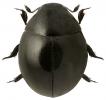
Accept cookies?
We use cook ies to give you the best online experience and to show personalised content and marketing. We use them to improve our website and content as well as to tailor our digital advertising on third-party platforms. You can change your preferences at any time.
Popular search terms:
British wildlife
- Wildlife Photographer of the Year
- Explore the Museum
Anthropocene
British Wildlife
Collections
Human evolution
What on Earth?

Stag beetles ( Lucanus cervus ) are the largest beetle not just in the UK but in Europe. The males can measure nearly 8cm long. © Achkin/ Shutterstock.com
During Beta testing articles may only be saved for seven days.
Create a list of articles to read later. You will be able to access your list from any article in Discover.
You don't have any saved articles.
Stag beetles: facts about the UK's largest beetle and where to see it
Flying haphazardly through the air on a balmy summer day, the male stag beetle is in a hurry to find a mate. Find out how he puts his spectacular antler-like jaws to use, why this species needs protection and how you can help.
Stag beetle populations are declining across much of Europe, but did you know London and the surrounding Thames Valley area are hotspots for this magnificent, rare beetle?
Max Barclay, Senior Curator in Charge of the Museum's beetle collection, says:
'Stag beetles are rare and threatened throughout northern Europe and the populations in the Thames Valley are some of the largest in the world. London is a particular stronghold.
'We're lucky that these beautiful and interesting creatures inhabit our city parks and gardens. We should make these gentle giants welcome and be proud to have them sharing our living spaces.'
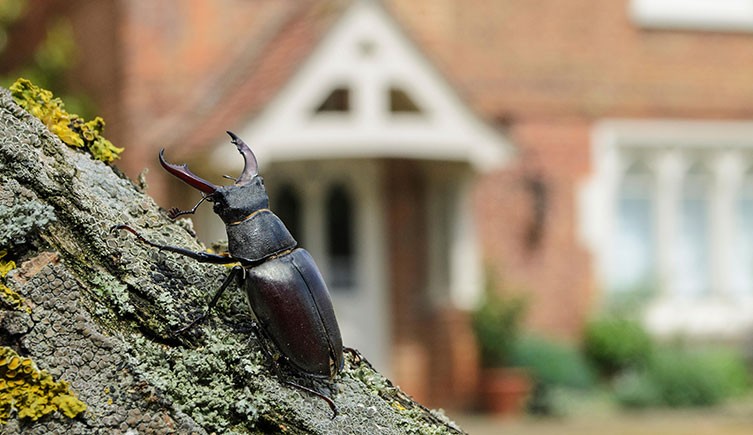
After decades of population declines, stag beetles ( Lucanus cervus ) are rare in the UK. London is a particular stronghold of the species. © Nature Picture Library/ Alamy Stock Photo
Read on to find out more about this charismatic beetle's lifestyle, impressive stats and why it needs our help.
Stag beetle fast facts
- Alternative common names: European stag beetle, greater stag beetle
- Scientific name: Lucanus cervus
- Length, including mandibles/jaws: males 35-75mm long, females 30-50mm long
- Weight: 2-6 grams
- Average lifespan: 3-7 years
- UK status: Native
- UK population: Unknown (you can help scientists find out )
- UK conservation status: Partially protected
- IUCN Red List category: Near Threatened on the European Red List of Saproxylic Beetles ( PDF )
Largest beetle in Europe: just how big can a stag beetle grow?
One of the most noteworthy things about stag beetles is their size. Male stag beetles measure up to 7.5 centimetres long when their impressive jaws are taken into account, making this species the largest beetle in the UK and in fact the whole of Europe.
How do other contenders measure up?
In the UK, the stag beetle beats its next rival for the biggest beetle record by a few centimetres. The great diving beetle ( Dytiscus marginalis ) , a voracious predator that lives in ponds, can reach about three centimetres long. Although it is aquatic, this beetle sometimes leaves the water and flies off to settle in a new pond.
The European rhinoceros beetle ( Oryctes nasicornis ) can be nearly six centimetres long, although two to four centimetres is more usual. One was discovered in the UK for the first time in 2013, in a Worcestershire garden. A lack of further sightings suggests the individual was an escaped pet or was accidentally imported on a plant from Europe. There is no evidence that a population has established itself in the wild in the UK.
Another contender for the title of Europe's biggest beetle is the great capricorn beetle ( Cerambyx cerdo ), which has a body length of four to five centimetres, excluding the antennae.
Explore other record-breaking beetles >

The great diving beetle ( Dytiscus marginalis ) is about the same size as a small female stag beetle. Its larvae can grow up to 10cm long, slightly shorter than stag beetle larvae. © Hector Ruiz Villar/ Shutterstock.com
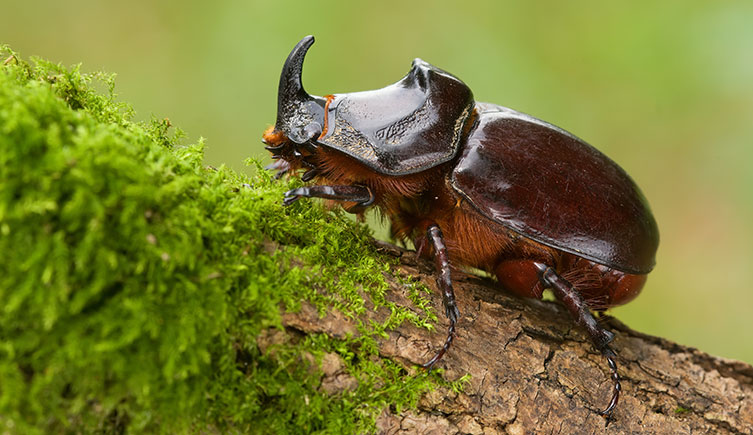
The European rhinoceros beetle ( Oryctes nasicornis ) is another beetle that uses its head ornamentation to challenge rivals for a female's affections. Its larvae can grow up to 10cm long. © Kluciar Ivan/ Shutterstock.com
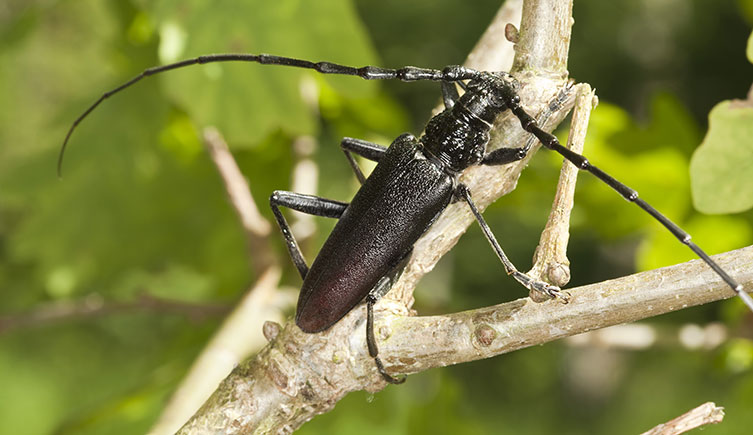
The great Capricorn beetle ( Cerambyx cerdo ) is extinct in Britain and has suffered declines in Europe due to the loss of its habitat © Henrik Larsson/ Shutterstock.com
The size of an adult stag beetle is influenced by the quality and amount of food it had access to as a larva. The smallest males are about four centimetres long. Even so, male stag beetles are usually considerably larger than female ones, which can be as little as three centimetres long.

Female stag beetles lack large mandibles (jaws) and can be half the size of males © WildMedia/ Shutterstock.com
The size of stag beetle larvae is even more impressive than the adult beetles. They can grow to around 11 centimetres long.
What do the male stag beetles use their massive mandibles for?
Male stag beetles use their large, antler-like jaws to battle each other for access to females during breeding season, much like a male deer uses its antlers. This is also where the beetle gets its name. Senior beetle curator Beulah Garner says, 'Male stag beetles use their magnificent mandibles as a warning signal to other males, raising them in a defensive or aggressive posture to fight off a contender.
'These beetles are skilful wrestlers and can even stand up on their hind legs to throw an opponent.'
The male beetles spend a lot of time and effort dislodging their opponent from where it clings. The more similar the jaw size of the rivals, the longer the battles last . The largest individual almost always wins.
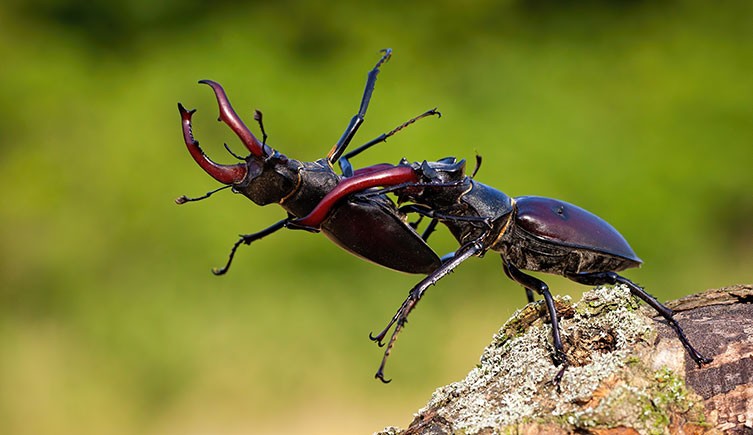
Battles between male stag beetles can be quite dramatic © WildMedia/ Shutterstock.com
Beulah adds, 'The male beetles also use their impressive antlers as part of their courtship display, circling the female with them raised and wide open.'
What do stag beetles eat?
Adult stag beetles don't eat, but they do drink sweet fluids such as tree sap and the liquid from decomposing fruit. They mostly rely on the energy stores they built up as a larva.
Stag beetle larvae feed on dead wood, using their sharp jaws to scrape the fibrous surface for splinters. Wood infested with white rot is a particular favourite as it helps to decompose the wood. The larvae also digest any fungi and other organisms in the wood.
The larvae seem to prefer the wood of oak trees but will also eat other broad-leaved species such as beech, willow, ash, elm, sycamore, lime, hornbeam, horse chestnut, apple, cherry and some garden varieties. They tend to avoid coniferous species such as fir and pine trees.
Since stag beetles only feed on dead wood, they don't pose a risk to living trees or shrubs.
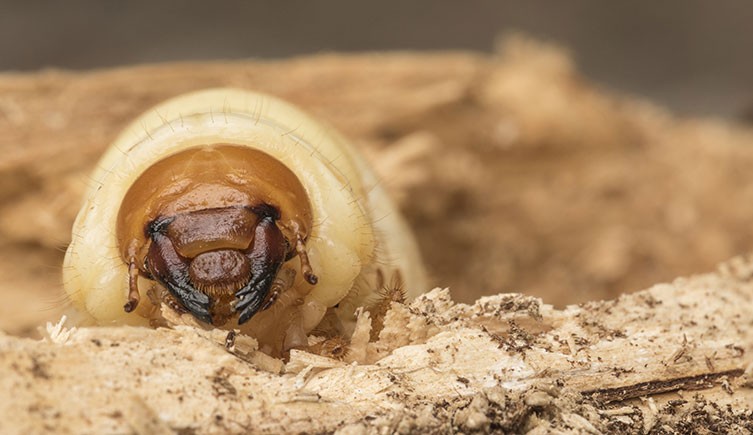
Although it is the massive adult male beetles that catch our attention, most of a stag beetle's life is spent underground as a larva eating dead wood © Carl Mckie/ Shutterstock.com
Where do stag beetles live?
In the UK, stag beetles mainly live in southeast England, although they are locally common along parts of the southwest coast and in the Severn Valley. They are most abundant around the Thames Valley, the New Forest in Hampshire and down to the south coast. The species is also found in central and southern parts of Europe.
Stag beetles' natural habitat is woodland, but they can also be found in hedgerows, traditional orchards and urban areas, particularly in parks and gardens with a lot of dead wood. London supports a nationally significant population.
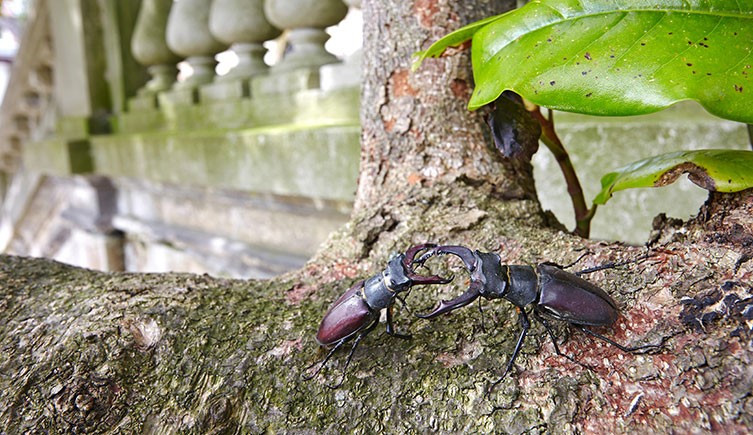
In southeast England and other parts of Europe where the species is found, stag beetles can be spotted in and around urban parks and gardens that contain plenty of dead wood © BIOSPHOTO/ Alamy Stock Photo
The females find it easier to dig down into light soil to lay their eggs. Areas with chalky soil, such as the north and south downs, have fewer stag beetles.
Why is London a hotspot for stag beetles?
Max explains, 'Stag beetles need warmth and the climate of southern England is more suitable for them than the rest of the country.
'They like Sun-exposed dead wood, so individual trees and stumps in gardens and parks may provide better, warmer conditions for the larvae to develop in than the shaded trunks and stumps of a dense forest.'
Across London, stag beetle beetles are far more common in the south and west. Central London lacks suitable habitat, but researchers don't yet know why the species isn't more abundant in north and east London.
Epping Forest and neighbouring areas in northeast London are an exception to this pattern. The forest is designated a European Special Area for Conservation, partly due to the presence of stag beetles. So are Richmond Park, Wimbledon Common and Putney Heath.
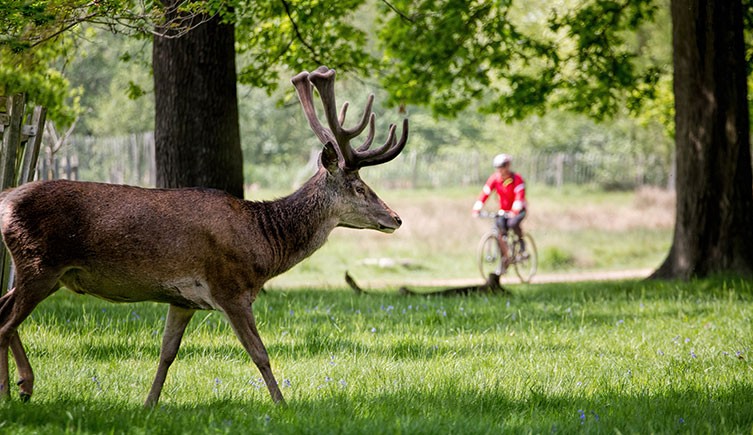
Richmond Park in southwest London - popular with visitors for its deer, including the male stags and bucks - is an important stag beetle site © jgolby/ Shutterstock.com
How long do stag beetles live?
Stag beetles live between three and seven years, on average. The vast majority of this time is spent as a larva underground, creating tunnels through the rotting wood they feed on.
Females lay their eggs - possibly as many as 30 - in dead wood or nearby soil. The eggs hatch after about three weeks and the larvae then spend several years feeding on decaying wood.
Beulah explains, 'How long the beetles spend underground in their larval state depends on the temperature and the nutritional content of the wood.
'The more decomposed the wood is, the less energy the larva has to spend on breaking up the wood fibre and the more fungi and other organisms are available to eat, so the larva can develop more quickly.'
Stag beetles undergo complete metamorphosis to transform from their larval to adult form. Pupation takes about six weeks and begins in the final autumn of the beetle's life cycle. The transformed adult leaves the pupa but remains underground until the following May or June when they emerge from the soil beneath logs and tree stumps. Adult males emerge first.
Max adds, 'The adults stay underground until the temperature reaches a certain consistent level. They usually burrow their way to the surface after warm summer rains when the ground is softer.'
Once above ground, adults only survive for a few weeks and their sole purpose is to mate. Males mate multiple times.
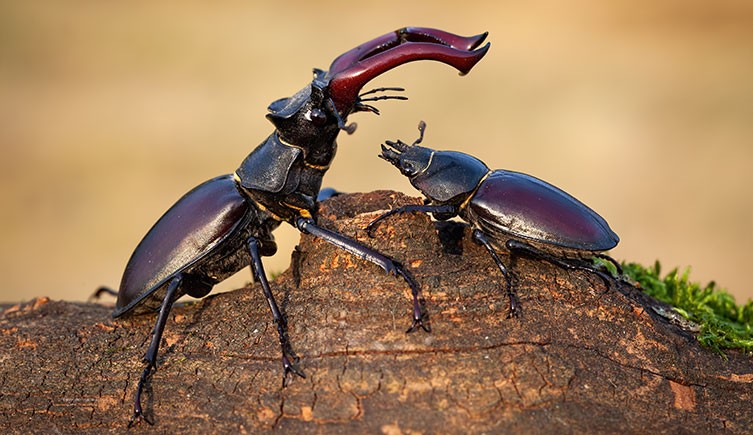
A male stag beetle tries to impress a female with his courtship display © WildMedia/ Shutterstock.com
How and when to see a stag beetle
Adult stag beetles are crepuscular, which means they are active mainly at twilight.
The males can generally be seen from mid-May to late July, especially on hot and humid summer evenings an hour or two before dusk, when they fly about looking for females. They can be attracted to light.
In urban areas with stag beetle populations, you may also notice them walking on the ground, particularly along roads and pavements, as they appear to be attracted to these warm surfaces.
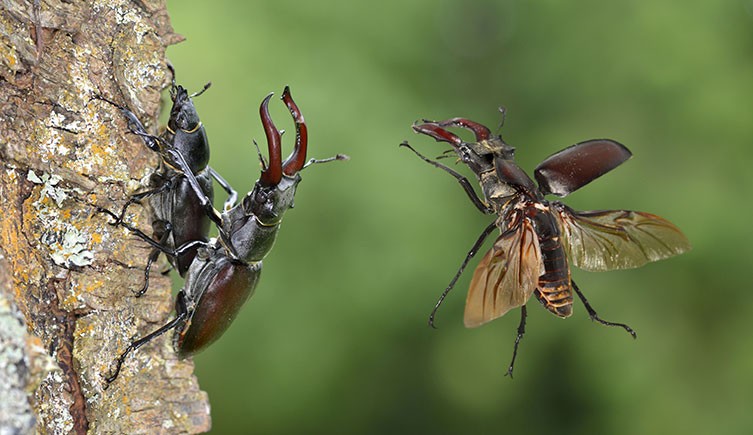
Male stag beetles have only a matter of weeks in summer to find a mate and there can be stiff competition © Nature Photographers Ltd/ Alamy Stock Photo
Due to their lifestyle, you're most likely to see stag beetles near areas of deciduous woodland or parkland with big, old trees and gardens containing plenty of dead wood. If you live in an area with stag beetles, you could increase your chances of an encounter by keeping dead wood in your garden.
Adult stag beetles generally die soon after mating and egg laying, usually by August.
You're unlikely to see a stag beetle larva unless you accidentally dig one up. If you do, try to put it back exactly where you found it. If that's not possible, bury it in a safe place with as much of the rotting wood from its original location as possible.

Lesser stag beetles ( Dorcus parallelipipedus ) are much more common than the female stag beetles ( Lucanus cervus ) they can be mistaken for. Here are tips on how to distinguish them. © TYNZA/ Shutterstock.com

The lesser stag beetle ( Dorcus parallelipipedus ) is matt black all over and has a squarer shape than a female stag beetle ( Lucanus cervus ) © Keith Hider/ Shutterstock.com
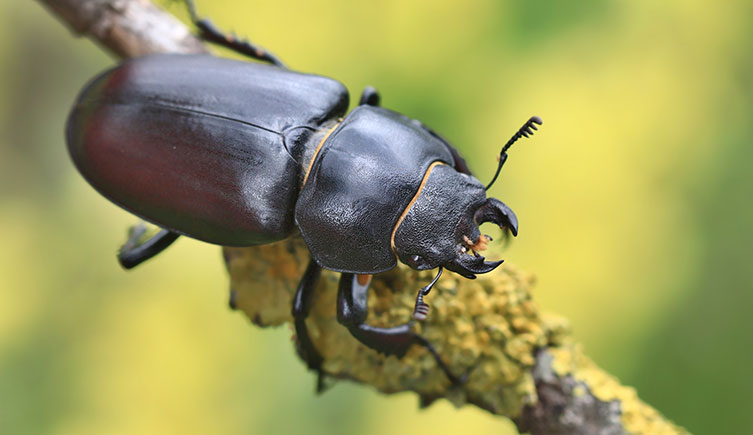
The wing cases of female stag beetles (Lucanus cervus) have a shiny brown tint © Monika Surzin/ Shutterstock.com

Both types of stag beetle can fly, but the female beetles do so less often than the males © Michal Fuglevič/ Alamy Stock Photo
Do female stag beetles fly?
Female stag beetles are capable of flight. Like most other beetles they have flight wings hidden under hardened outer wings. However, you're far more likely to see them on the ground looking for a suitable spot to lay their eggs.
They tend to return to the place where they hatched to lay their own brood, often even the same piece of wood. Max adds, 'The females don't usually move very far unless they have to.'
It's the males you're more likely to see flying - often disconcertingly at about face height, which can be quite a shock as they're so large and ungainly. It's an amazing sight.
A stag beetle flying in Putney, south London. Video by Neil Stoker.
Are stag beetles dangerous?
No, despite their intimidating appearance, stag beetles are harmless and you can safely pick them up to move them out of harm's way.
The males can move their jaws just enough to give you a bit of a pinch, but they will only do so if you encourage them. The females' jaws are a bit stronger and capable of biting, but they aren't aggressive.
Max says, 'There really is no need to fear these beetles. They are not dangerous. I've never been bitten by one.'
Stag beetles are good for gardens, parks and woods
Stag beetles are a beneficial part of garden and woodland ecosystems.
Max explains, 'Stag beetles are important for recycling and breaking down dead wood and returning the nutrients to the soil.
'A number of smaller insects and fungi depend on their activities, especially the wood-burrowing activity of the larvae. They also provide food for birds.'
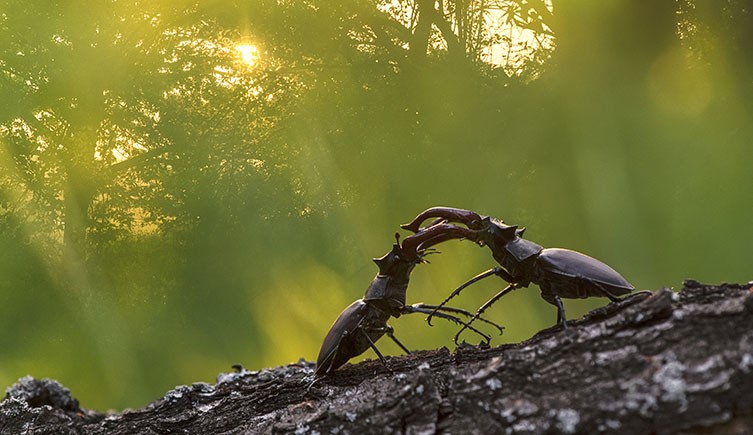
Stag beetles may spend their short time as adults flying, fighting, mating and laying eggs, but the species plays a beneficial role in ecosystems, particularly the larvae © Evgeniy Melnikov/ Shutterstock.com
Are stag beetles endangered?
Stag beetles are a priority species for conservation in the UK. Although their numbers seem to have stabilised recently, this follows decades of significant declines, and their distribution is far more contracted than it used to be.
The situation is even more serious in Europe, where stag beetle populations are still decreasing. The species disappeared entirely from Latvia and Denmark, although it has since been successfully reintroduced to the latter.
The main reason the species is struggling is the loss of its key habitat - dead wood - due to the tidying up of woodland, parks and gardens, and as broad-leaved woodland has been turned into farmland, forestry plantations and urban developments.
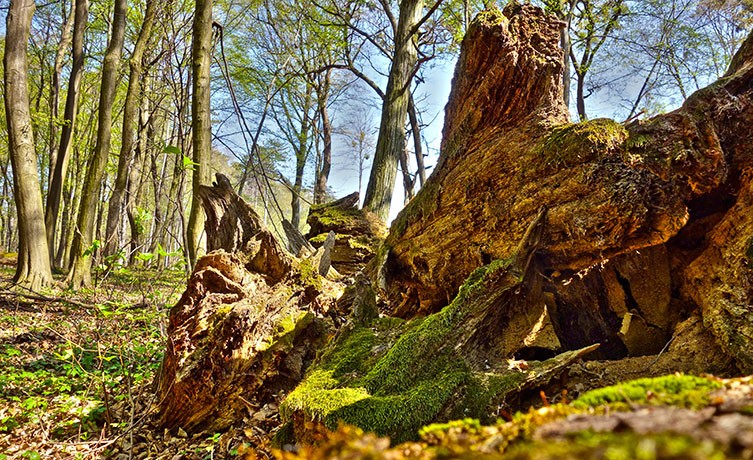
Stag beetles rely on rotting tree stumps and other dead wood. Much important habitat has been lost through the tidying and redevelopment of woodland. © tonytao/ Shutterstock.com
In urban areas, stag beetles are prone to being run over by cars. They also face a lot of predation from cats, foxes, crows and magpies.
Max says, 'Unnecessary clearing up and destruction of dead wood, and the conversion of woodland and forest habitats for agriculture or development have impacted the stag beetle, as no doubt did a cooling period during the nineteenth century. Killing of adults by cars, cats and thoughtless people may also contribute to their decline.'
However, there is hope for this species, adds Max.
'Like most of the rest of biodiversity, stag beetles have declined because of human alteration of the landscape. However, they are better off than many species because they can survive and breed in single trees and stumps in highly modified environments - as their success in London shows.
'Raised awareness of stag beetles and their needs seems to be helping.
'Also, today people are more sensitive to nature and are less likely to kill first, think later, when faced with a strikingly large beetle!'
Stag beetles are protected
Lucanus cervus is a protected species in the UK, covered by the amended Wildlife and Countryside Act 1981. The protection aims to prevent the beetle from being collected for sale.
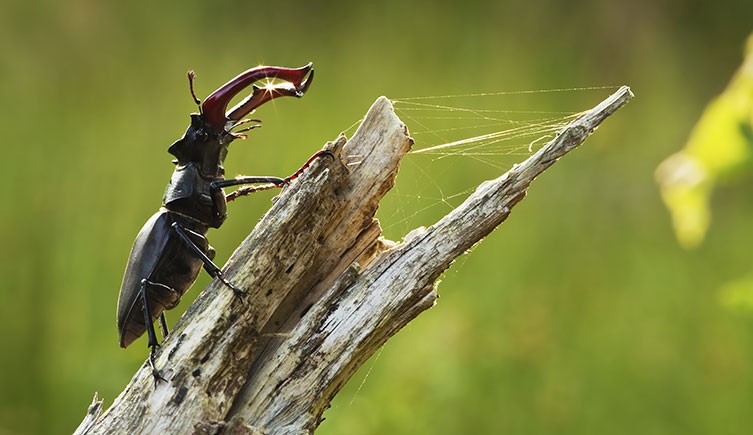
The majestic stag beetle ( Lucanus cervus ) needs your help © Henrik Larsson/ Shutterstock.com
Five ways to help stag beetles
Beulah has these top tips for how you can help stag beetles: 1. Provide dead wood . Set aside an undisturbed space in your garden for a dead wood pile . Partially bury some, as the wood the young larvae feed on needs to be quite damp and rotten. Even wood chip would be appreciated.
If you are cutting down a tree, try and leave the stump in place or rebury it in an undisturbed corner.
Max adds, 'Providing dead wood in your garden can really make a difference to these beetles as they rely on it. Partially buried dead wood is best because the humidity remains constant and high. Not only will it make a useful stag beetle nursery, but it will also support a wide range of other insects and fungi.
'You can also help by fighting against deforestation and habitat destruction, not only on a grand scale, but even just casual tidying up of dead wood by councils or individuals.'
Stag beetles are just one of 650 beetle species in the UK that depend on dead wood . So even if you don't have stag beetle populations in your area, it's still worth doing this.
2. Don't use mulch or polythene as newly emerging beetles can become trapped and die.
3. If you spot a stag beetle on a road or pavement where it's likely to be run over or stepped on, move it to a safer spot in nearby vegetation.
4. Cover water butts and keep an eye out for the beetles in ponds - they can't swim but you can save them from drowning if you rescue them soon enough.
5. Record any stag beetle sightings on the Great Stag Hunt website - it is valuable information for conservationists.
Your record will form part of a national database kept by the People’s Trust for Endangered Species (PTES), which helps scientists to track the changing distribution of stag beetles across the UK.
PTES is also part of a Europe-wide study to monitor how many stag beetles there are and how this is changing year-on-year. Find out how you could take part .
- Urban wildlife
- Biodiversity
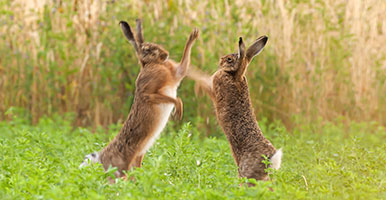
Find out about the plants and animals that make the UK home.
Get closer to nature

Do your bit for nature
Small actions can make a big difference.
Here's how you can help protect biodiversity.

You are invited to make your mark in the Museum gardens
From sponsoring a square metre of garden to dedicating a bench to a loved one, a donation to the Urban Nature Project is the perfect way to show your love for urban wildlife.
Discover more

UK beetles: 17 of the most spectacular and beautiful
Discover some standout British beetles, including a particularly vibrant ladybird and a rare rainbow-coloured leaf beetle.
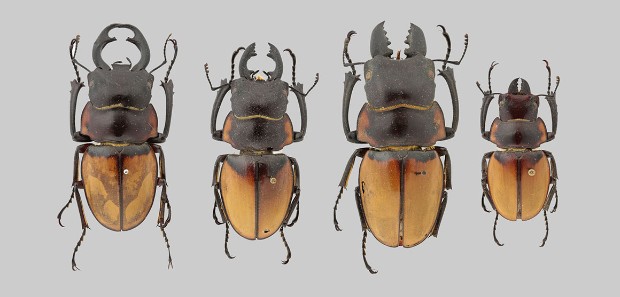
The stag beetles with bolt-cutter jaws
A fourth mandible variation has been identified in some species of Odontolabis stag beetles and it's been named 'Boltcutter'.
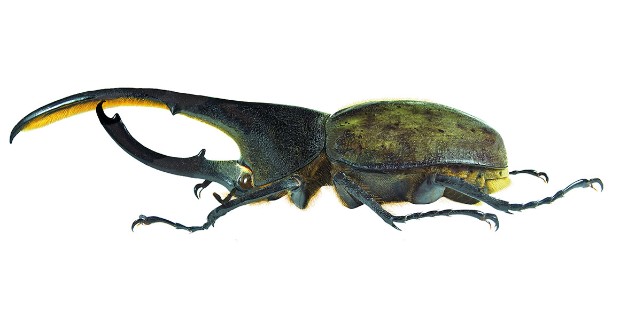
How big can beetles get?
We may often think of beetles as being relatively small, but there are some species that reach extraordinary sizes.
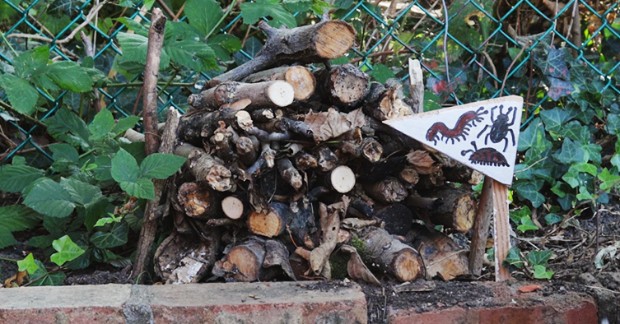
How to make a log pile to provide shelter for garden wildlife
A log pile can give home and shelter to some of the smaller inhabitants of your garden.
Don't miss a thing
Receive email updates about our news, science, exhibitions, events, products, services and fundraising activities. We may occasionally include third-party content from our corporate partners and other museums. We will not share your personal details with these third parties. You must be over the age of 13. Privacy notice .
Follow us on social media
The wildlife and wild places of Leicestershire and Rutland

Discover Identify Record
- Species library
- Carabidae - Ground beetles
- Black Clock Beetle
Black Clock Beetle - Pterostichus madidus
- Species account
- Additional images
A large (15-20 mm) shiny black ground beetle with either all black legs or wine-red legs (variety concinnus ). The well-rounded pronotum helps to distinguish this species from other similar ground beetles.
Lives under stones, loose bark and grass tussocks. It is a very common beetle in gardens and on arable land.
The species breeds in the autumn and the larvae overwinter. Adults are most common in the summer months.
Largely predatory on many ground-living invertebrates, including caterpillars and slugs, but the adult also eats some plant material.
Common and widespread in Britain.
Common in Leicestershire and Rutland. There were a total of 391 VC55 records for this species up to March 2015.
Leicestershire & Rutland Map
Enter a town or village to see local records
Yellow squares = NBN records (all known data) Coloured circles = NatureSpot records: 2020+ | 2015-2019 | pre-2015
Species profile
Total records by month, % of records within its species group, 10km squares with records.
The latest images and records displayed below include those awaiting verification checks so we cannot guarantee that every identification is correct. Once accepted, the record displays a green tick.
In the Latest Records section, click on the header to sort A-Z, and again to sort Z-A. Use the header boxes to filter the list.
Latest images
Latest records.
- About BBC Wildlife
- Competitions
- Insects & Invertebrates
- Marine animals
- Water Plants
- Wildlife Garden
- North America
- South America
- Travel Planner
- Identify Wildlife
- How to make things
- Watch Wildlife
- Photograph Wildlife
- Photography Masterclasses
- Wildlife Gardening
- Meet The Scientist
- Tales from the Bush
- Mental health and wellbeing
- Wildlife Champion
- Environment
- Current issue
- Meet the team
- History of BBC Wildlife
How to identify beetles
From tiny weevils to huge stag beetles, the beetles are an incredibly varied in group in size, shape, colour and behaviour. Discover some of the species to look out for.
In Britain few groups are as colourful and varied as the beetles. We have over 4,000 species, including no fewer than 300 ground beetles. The beetle species illustrated below are relatively abundant and easy to identify.
Most of these species are active by day and can be seen in parks or gardens, though a couple will take a bit more searching. The dor beetle, for example, is mostly found on dung-strewn grassland, while the carrion beetles – undertaker of the beetle world – seeks out corpses to bury as a larder for its grubs.
Good methods to find beetles include sifting leaf litter, peering under logs and stones, checking foliage, and burying pitfall traps in flowerbeds overnight. Try making a pooter , an easy-t0-make bit of equipment for catching and looking at small invertebrates without touching them.
Learn more about beetles and identifying invertebrates:
- How to identify carrion beetles
- How to identify longhorn beetles
- How to identify pond wildlife
- How to identify insects and invertebrates under logs and stones
All illustrations by Dan Cole/The Art Agency, unless otherwise credited.
2-spot ladybird ( Adalia 2-punctata )
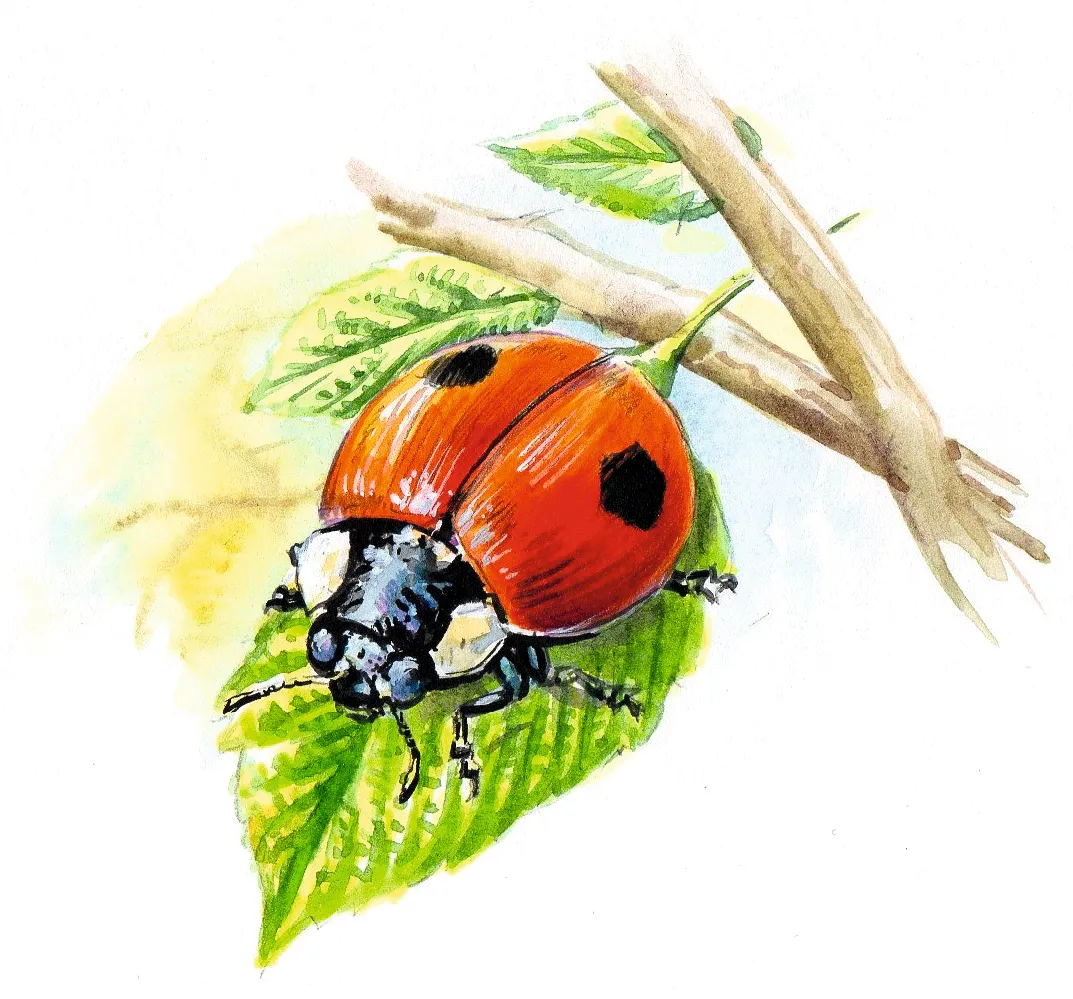
4–5mm. Usually two black spots on red wingcases; forms with red spots on black also exist. Now declining.
7-spot ladybird ( Coccinella 7-punctata )

5–8mm. Seven black spots on red wingcases. The most abundant and frequently seen native ladybird.
Harlequin ladybird ( Harmonia axyridis )

7–8mm. Very variable; often red with black spots, or black with red spots. Non-native; predator of UK ladybirds.
Leaf weevil ( Phyllobius pyri )

5–7mm. Elongated head and ‘beak’; green with gold spangles, becoming darker with age. On trees and shrubs.
Lily beetle ( Lilioceris lilii )
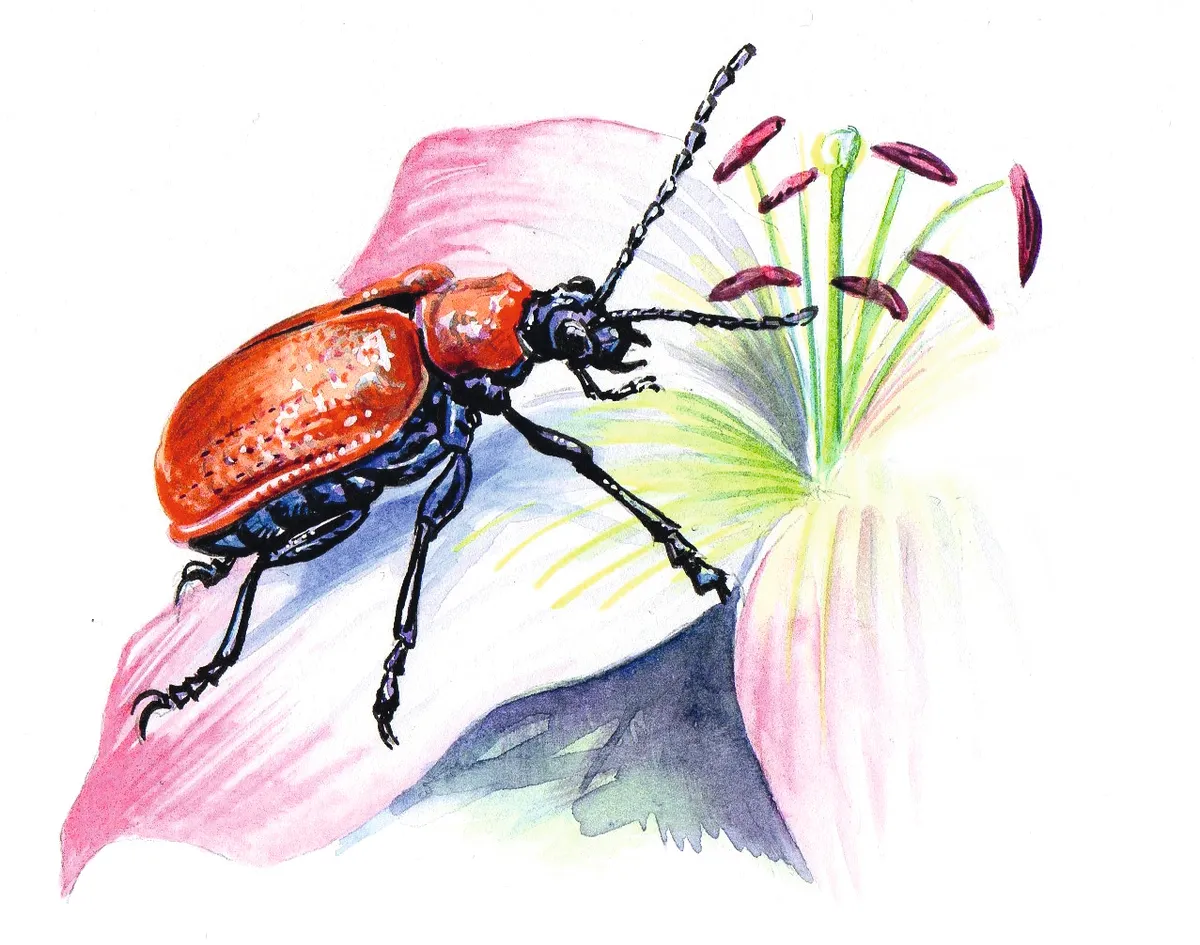
6–8mm. Non-native; feeds on lily leaves and buds. Spreading north, recently reaching Scotland. Similar in appearance to the black-headed ( Pyrochroa coccinea ) and red-headed ( P. serraticornis ) cardinal beetles.
Thick-legged flower beetle ( Oedemera nobilis )

8–10mm. Iridescent green, with long, narrow wingcases and swollen thighs. Feeds on pollen in flowery places.
Dor beetle ( Geotrupes sterocorarius )
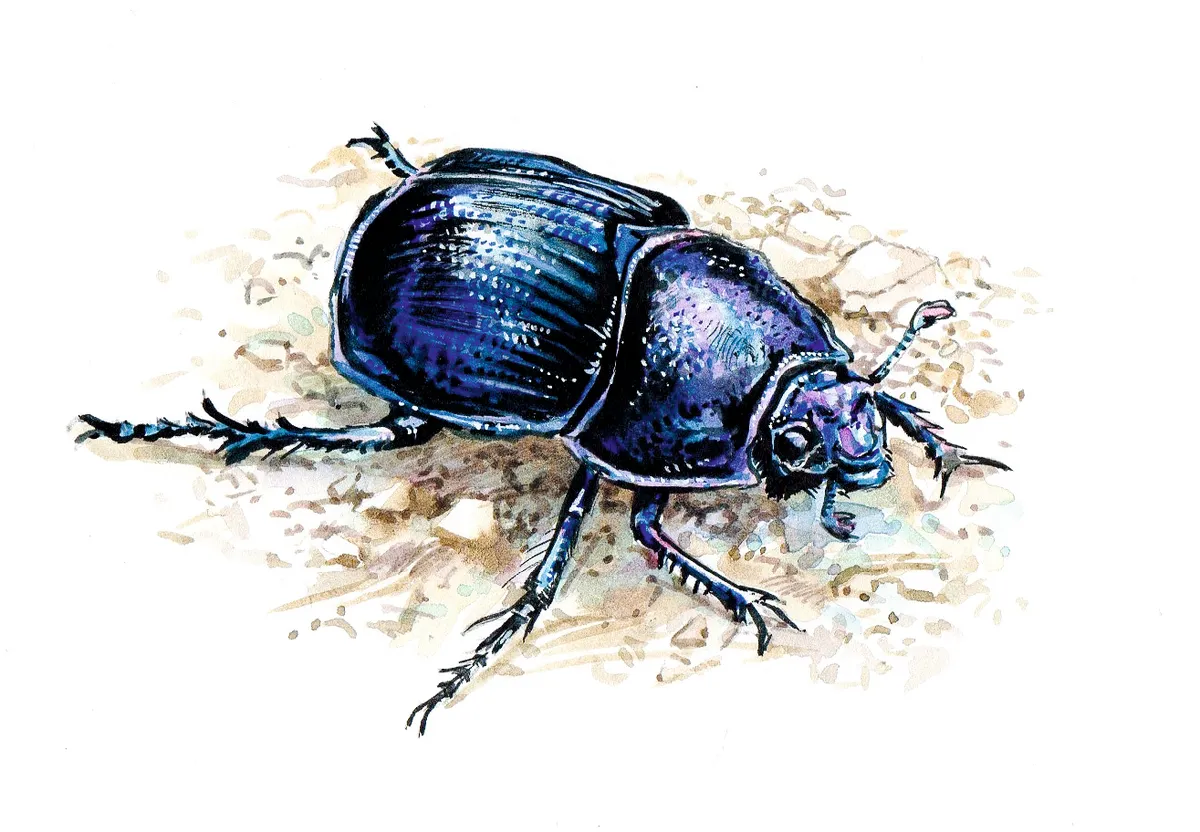
15–25mm. Shiny with a bluish tinge, spiky legs and grooved wingcases. Larvae feed on dung in grassland.
Devil's coach horse beetle ( Ocypus olens )
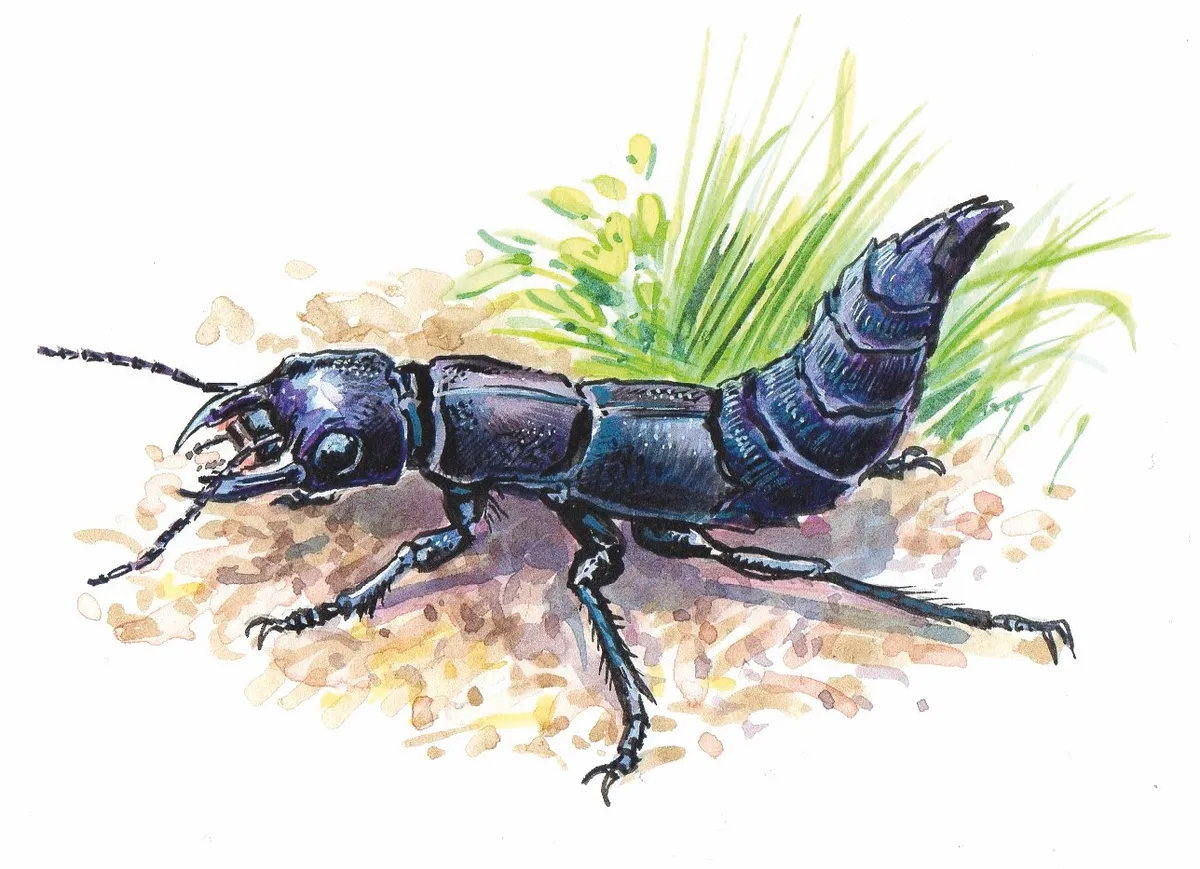
20–30mm. Long body and very large jaws. Lifts tail if alarmed. Hides under logs, stones or leaves; hunts at night.
Violet ground beetle ( Carabus violaceus )
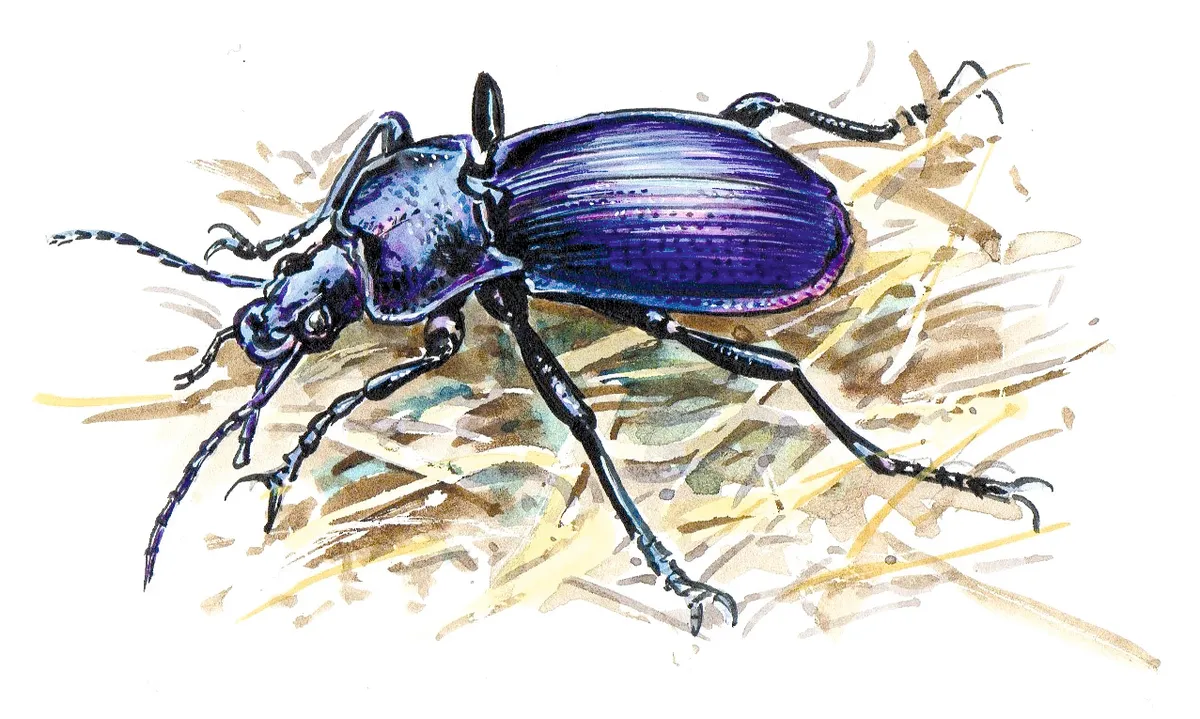
20–30mm. Shiny body has purplish sheen. Active nocturnal predator; by day hides under logs and stones.
Ground beetle ( Poecilus cuprous )
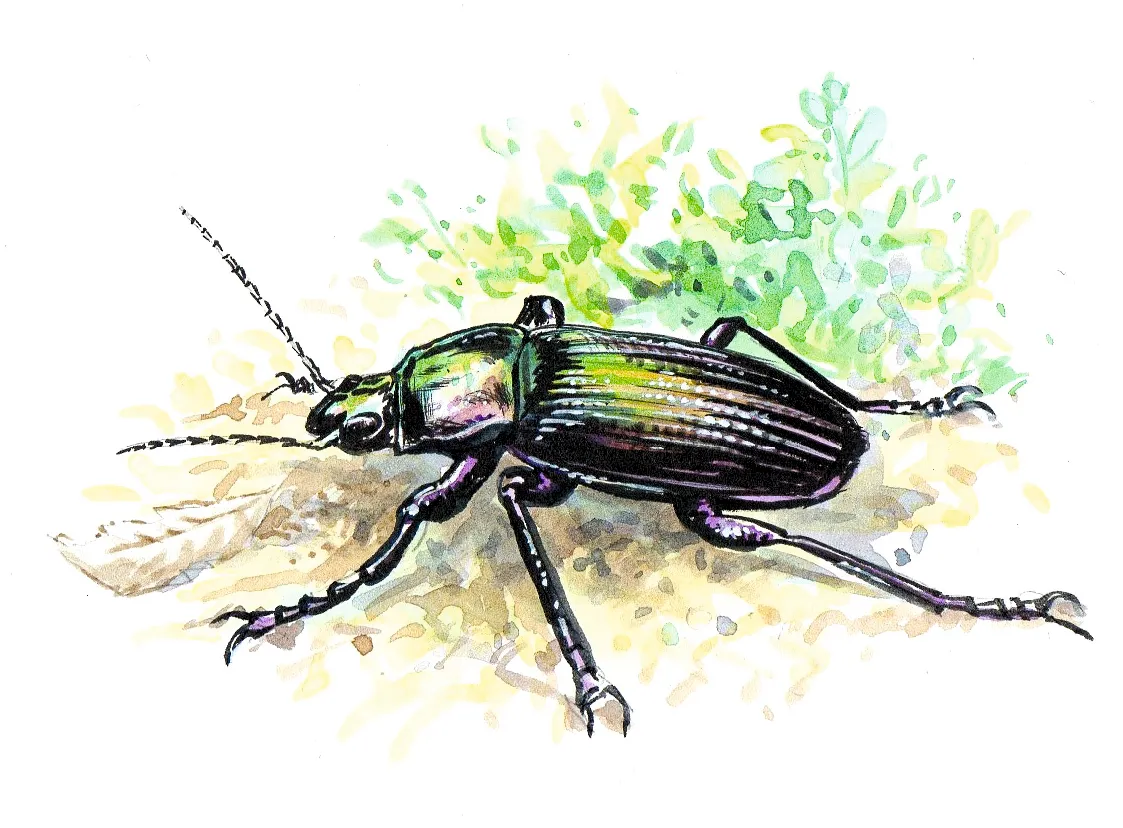
11–13mm. Green or coppery sheen; grooved wingcases. Open, dry, grassy areas; less common in north.
Ground beetle ( Notiophilus biguttatus )
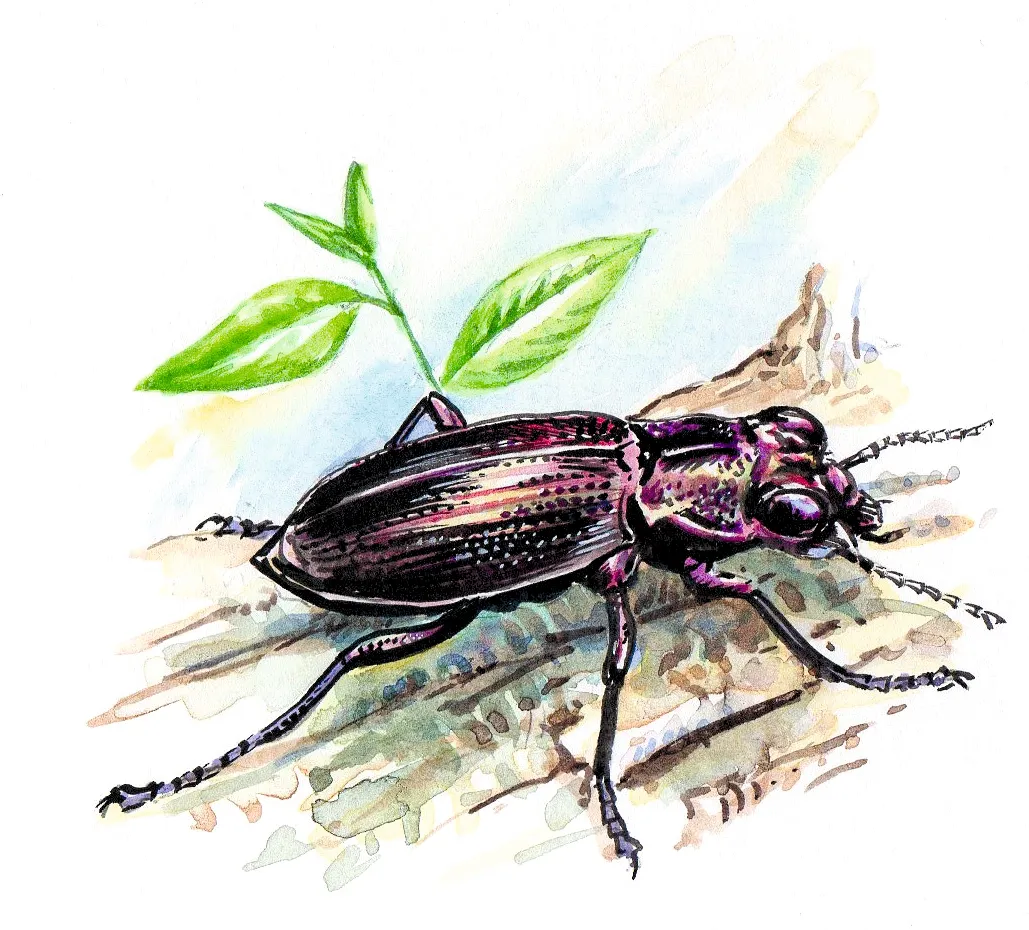
5–6mm. Small, with proportionately huge eyes. Hunts tiny springtails and mites on paths and in flowerbeds.
Ground beetle ( Abax parallelepipedus )
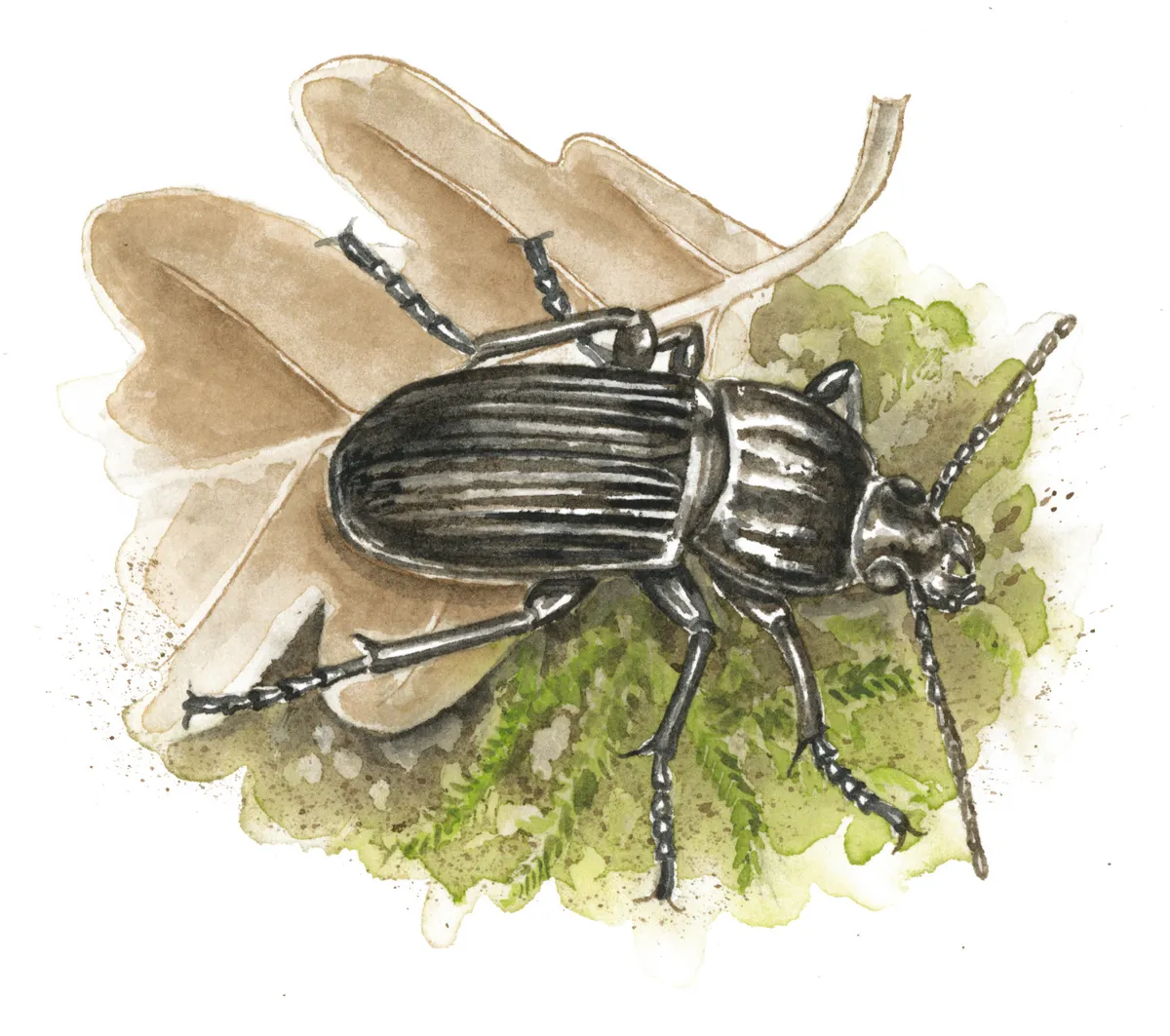
17–22mm. Black beetle with grooved wingcases. Eats earthworms and other soft-bodied invertebrates.
Carrion beetle ( Nicrophorus investigator )
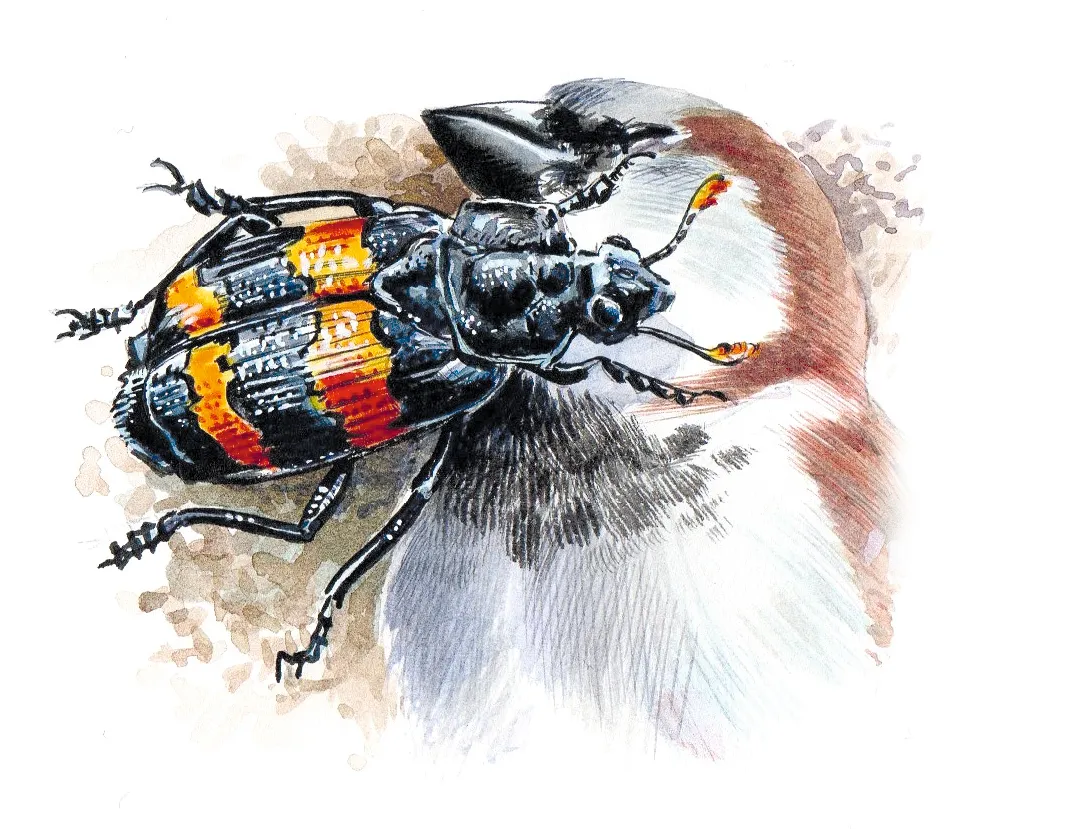
Up to 22mm. Attracted to dead birds and mammals, which its larvae eat. A number of the Nicrophorus species look similar.
Carrion beetle ( Silpha atrata )
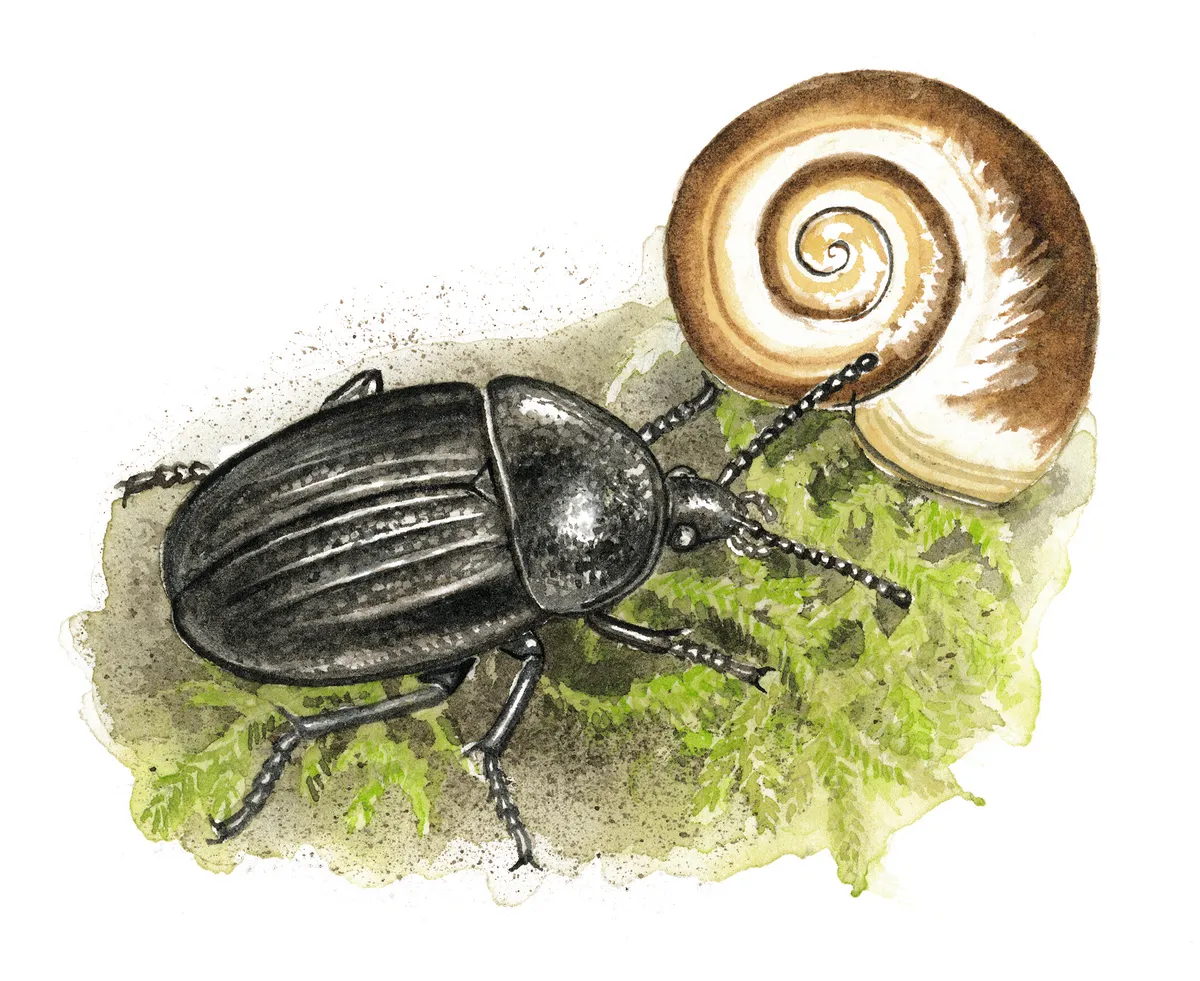
10–15mm. Mat-black beetle with broad wingcases. Feeds on snails and a wide variety of carrion.
Buzzing snail-hunter ( Cychrus caraboides )
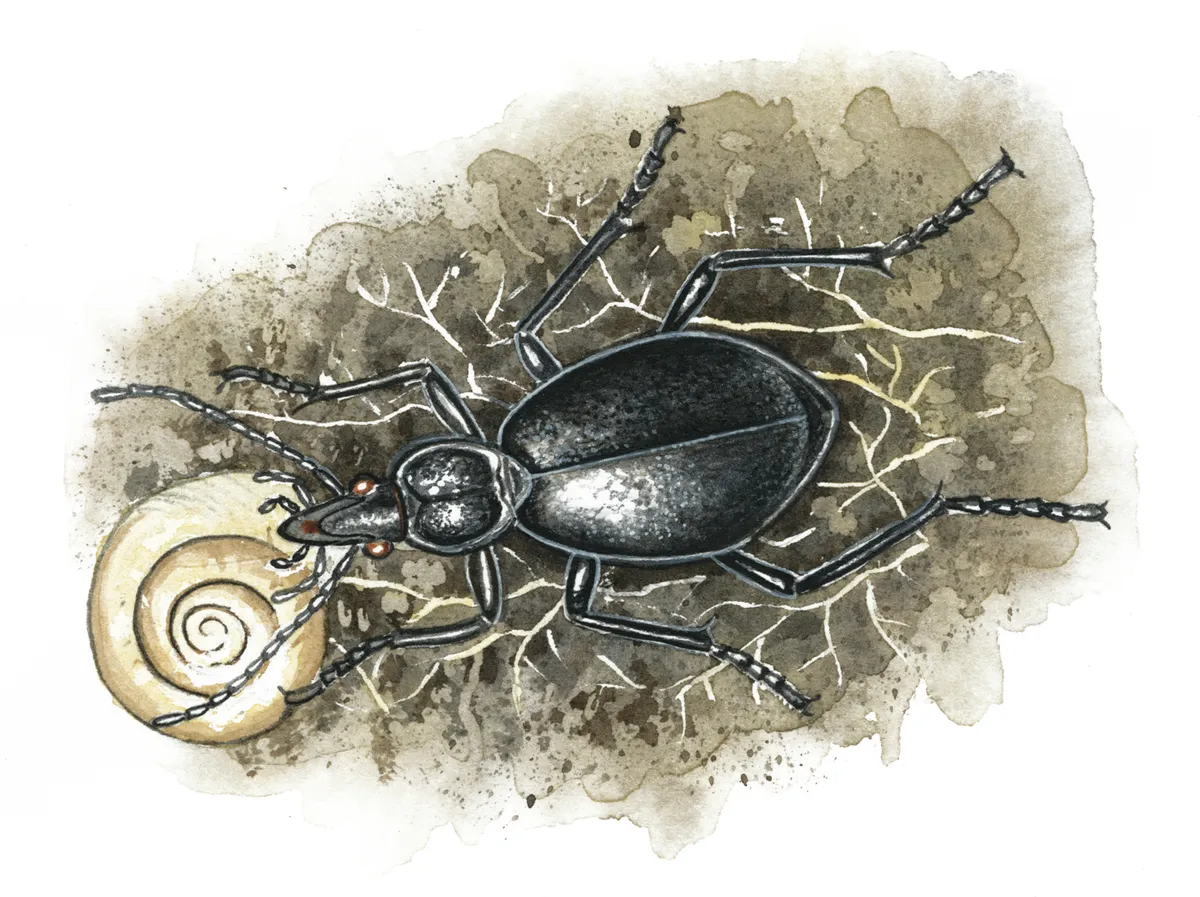
15–20mm. Long ‘snout’ probes snail shells. Also eats wide range of soft-bodied prey. Buzzes when handled.
Wasp beetle ( Clytus arietis )

6–15mm. Abundant, fast-moving wasp mimic. Frequently basks on sunlit logpiles, stumps and leaves. The wasp beetle is part of the longhorn beetle family .
Main image: A 7-spot ladybird on a flower. © Jacky Parker Photography/Getty
Share this article

- Terms & Conditions
- Privacy Policy
- Cookies Policy
- Code of conduct
- Subscription
- Manage preferences

- UK Safari Home
- Identify It
- What's Out Now?
- Search Contents
Old School Search Tool
This is what's known as an "index". If you're old enough to remember real books you'll be familiar with how this works. The main sections are shown in bold, and all the pages in each section are listed alphabetically.
Amphibians Common Frogs Great Crested Newts Common Toads Natterjack Toads Bats Brandt's Bats Brown Long-eared Bats Common Pipistrelle Bats Daubenton's Bats Whiskered Bats Beetles Bloody-nosed Dor Beetle Glow-worms Ladybird 7-spot Rosechafer Rosechafer Sightings Stag Beetle Birds Barn Owl Birds of Prey Section Birds sunbathing Black-headed Gulls Buzzards Carrion Crows Coots Cuckoos Eagle Owls Gannets Golden Eagles Goldfinches Great Crested Grebes Great Spotted Woodpeckers Green Woodpeckers Hen Harrier Jay Kestrels Kingfishers Little Owls Long-eared Owls Mallard Ducks Mute Swans Ospreys Owl Section Ptarmigan Puffins Ravens Redwings Robins Rooks Short-eared Owls Snow Buntings Snowy Owls Song Thrushes Sparrowhawks Starlings Swallows Tawny Owls Whooper Swans Wood Pigeons Buried Treasure Butterflies Brimstone Butterflies Comma Butterflies Common Blue Butterflies Dingy Skipper Butterflies Marbled White Butterflies Orange Tip Butterflies Peacock Butterflies Purple Emperor Butterflies Red Admiral Butterflies Ringlet Butterflies Small Skipper Butterflies Speckled Wood Butterflies Swallowtail Butterflies Tortoiseshell Butterflies Caterpillars Deer Fallow Deer Red Deer Reindeer Roe Deer Creepy-crawlies - see Invertebrates Dandelions Dophins - see Marine Mammals Dragonflies Black-tailed Skimmer Dragonflies Broad-bodied Chaser Dragonfly Golden-ringed Dragonflies Migrant Hawker Dragonflies Freshwater Wildlife Backswimmers / Water Boatmen Freshwater Shrimps Three-spined Sticklebacks Fungi Section Birch Bracket Candle Snuff Fly Agaric Giant Funnel Jew's Ear Sulphur Tuft Verdigris Yellow Stagshorn Identify It Section Insect Hotel - how to make Invertebrates Ants Bee - Ashy Mining Bee Fly Bee - Bumblebees Butterflies Bee - Carpenter Bee - Nomad Beetles Centipedes Crane Flies Earthworms Earwigs Grasshoppers Harvestmen Lacewings Ladybirds Millipedes Moths Scorpion Flies Slugs Spiders Ticks Woodlice Ladybirds 7-spot 14-spot 16-spot Orange 22-spot Mammals Badgers Bank Voles Bats Brown Hares Dormice Fallow Deer Foxes Grey Squirrels Hedgehogs Irish Hares Moles Mountain Hares Red Deer Red Squirrels Reindeer Roe Deer Stoats Weasels Wildcats Wood Mouse Marine Mammals Dolphins - Bottle-nosed Dophins - Common Common Seals Grey Seals Marine Wildlife Basking Sharks Goose Barnacles Limpets Mussels Seashells Starfish Moss Moths Buff Tip Common Footman December Moth Elephant Hawkmoth Elephant Hawkmoth Sightings Hummingbird Hawkmoth Jersey Tiger Jersey Tiger Moth Sightings Old Lady Privet Hawkmoth Scarlet Tiger Spring Usher Owls Barn Owl Eagle Owls Little Owls Long-eared Owls Short-eared Owl Snowy Owls Tawny Owl Plants - see Wild Flowers Photo of the Week Reptiles Adders Common Lizards Grass Snakes Sand Lizards Slow-worms Spiders Black Lace Weaver Spiders Buzzing Spiders Cave Spiders Comb-footed Spiders Crab Spiders Daddy Long Legs Spiders Deadly Spiders False Widow Spiders Funnel Web Spiders Garden Spiders House Spiders Labyrinth Spiders Lace Web Spiders Missing Sector Spiders Mouse Spiders Nursery Web Spiders Spider Tickling Stone Spiders Tube Web Spiders Walnut Orb-weaver Spiders Wasp Spiders Woodlouse Spiders Swimming with Dolphins Tips for Hand Rearing Moths Trees Common Oak Hazel Horse Chestnut Silver Birch Why do Leaves Fall in Autumn? Whose Nuts are These? Wild Flowers Bird's-foot Trefoil Bluebells Butterbur Dandelions Mistletoe Snake's-head Fritillaries Snowdrops Wood Anemones Woodlice Ant Woodlice Common Pill Woodlice Common Rough Woodlice Common Shiny Woodlice Southern Pill Woodlice
Related Pages

Popular Pages
Amphibians , Bats , Badgers , Beetles , Birds , Birds of Prey , Bumble Bees , Butterflies , Caterpillars , Climate Change , Deadly Spiders , False Widow Spiders , Frogs , Funny , Garden Spiders , Glow-Worms , Hedgehogs , House Spiders , Owls , Spiders , Toads , What's Out Now?
Copyright © 2024 G. Bradley UK Safari. All rights reserved | About Us | Links | Advertise | Contributors

IMAGES
COMMENTS
Longhorn - Golden. Longhorn - 2-banded. Mint Leaf Beetle. Noble Chafer. Oil Beetle. Poplar Leaf Beetle. Rhinoceros Beetle. Rose Chafer. Rosemary Leaf Beetle.
Close up photos and information about beetles found in Great Britain and Northern Ireland. UK Safari Home; Identify It; Free Newsletter - Grab one now! Search Contents; Beetles. Identify It > Beetles > Bloody-nosed. Dor Beetle. Glow-worms. Ladybird 7-spot. Rose Chafer. Stag Beetle. Popular Pages.
Scientific name: Lucanus cervus. Size: Male Stag Beetles grow to about 90mm in length, including the antlers, and female Stag Beetles grow to around 60mm. Distribution: Found mainly in the south and south east of England. Hot spots for the Stag Beetle are Dorset, Surrey, Greater London (especially Bromley, Croydon and Lewisham), Essex, Kent ...
Blue Mint Leaf Beetles. Identify It > Invertebrate Section > Beetle Section > Blue Mint Leaf Beetles >. Scientific name: Chrysolina coerulans. Size: Up to 10mm long. Distribution: A few sightings in Kent and Cambridgeshire in England. Months seen: May to September. Life span: Just over 1 year. Habitat: Gardens, damp meadows and riversides.
The hardened outer wings, called elytra, protect the flight wings underneath.'. So, it is fitting that the scientific name for beetle is 'Coleoptera' - coleo from the Greek for sheath, and ptera meaning wing. Here are 17 of the most beautiful and standout UK beetles: 1. Rose chafer ( Cetonia aurata)
Beetles can be found throughout the UK, with many visiting gardens. We've put together a guide to identifying some of the more common or noticeable species. ... Beetles are one of the most diverse groups of animals on the planet, with over 400,000 different species across the world — there are over 4,000 species in the UK alone! Even without ...
Dor Beetles. Identify It > Invertebrates Section > Beetles Section > Dor Beetles > Latin name: Geotrupes stercorarius Size: Grows to 25mm long Distribution: Found throughout the UK Months seen: April to October Habitat: Farmland and woodland Food: Dung, especially cow dung Special features: The Dor beetle is one of the largest dung beetles in the UK. Dung beetles get their name from their ...
Latin name: Lilioceris lilii Size: 8 to 10mm long Distribution: Mainly found in Wales, and England. Recently reached Scotland. Months seen: April to August. Habitat: Found in gardens on lily plants. Food: Lily leaves. Special features: Lily beetles arrived in Britain on imported flowers in the early 1900's. They are similar in appearance to cardinal beetles, however, they have a much more ...
Here is BBC Countryfile Magazine's guide to British beetle species, from cockchafers to stag beetles.
UK Safari is a site for Anyone Interested in the Wildlife of Great Britain and Northern Ireland. The UK Safari website has been entertaining nature lovers since March 2000. It contains thousands of photos and files about the wildlife of the United Kingdom. ... Amphibians, Bats, Badgers, Beetles, Birds, Birds of Prey, Bumble Bees, Butterflies, ...
There are several similar species, all commonly known as Sexton beetles or burying beetles. They get their name from the practice of digging a hole beneath a dead animal and then pulling the body down into the hole. This photo (click left) shows a blackbird buried by sexton beetles, with just a few feathers showing above the ground.
Special features: The wing casings on the bee beetle vary in colour from creamy-yellow to deep orange. The bodies are very hairy and resemble bumble bees - hence the name. Bee beetles are found mainly on the flowers of thyme and roses. UK Safari Beetle Section UK Safari Creepy-Crawlies Section
Handsome Fungus Beetles. 8 species. 1-6 mm. Pronotum with impressed lines or basal fovea. Very variable and only sensibly arrived at by reference to good pictures, this is a reasonable way to deal with the few UK species as each is very characteristic regarding colour, size and (especially) the form of the pronotum. Tarsal formula 3-3-3 or 4-4-4.
Beetles make up a significant portion of the insect population in the UK, with over 4,000 species recorded. Their presence in various habitats indicates the overall health of ecosystems. By understanding and preserving different beetle species, we contribute to the overall conservation of the natural world.
Staphylinidae (Rove beetles, staphs). 1130 species. 1-24mm. Tarsi: 3-3-3, 5-5-5. Lobed or not. A huge family of beetles. Almost all of them have very short wing-cases leaving at least three segments of the abdomen exposed. Most of them are slender and long. Geotrupidae (Dor beetles). 8 species. 11-26mm.
Special features: Bloody-nosed beetles are one of the largest leaf beetles found in the UK. They can sometimes be found walking slowly over grassy areas in spring and early summer. The body has an irridescent blue-black sheen, and the antennae have the appearance of a tiny black string of pearls. ... UK Safari Beetles Section; UK Safari ...
In the UK, the stag beetle beats its next rival for the biggest beetle record by a few centimetres. The great diving beetle (Dytiscus marginalis), a voracious predator that lives in ponds, can reach about three centimetres long.Although it is aquatic, this beetle sometimes leaves the water and flies off to settle in a new pond.
Beetles. In Britain, there are at least 3,700 species of beetle with the ladybird being the most well known. Like all insects, beetles have six jointed legs, a head, thorax and abdomen. They are ...
The adult beetles live for up to 8 weeks. Habitat: Woodlands, parks and gardens Food: The larvae eat rotting wood. The adults only drink tree sap Special features: Stag Beetles are the largest beetles found in the U.K. and they're now quite rare. The decline of our Stag Beetles is mainly as a result of habitat loss.
Distribution: Found throughout the UK. Months seen: May to August Habitat: Anywhere near dead wood. Frequently found on the timbers of houses and on wooden furniture. Food: As the name suggests, they eat wood. Special features: Woodworm beetles are brown all over, and quite hairy. They normally appear between May and August to mate, after which ...
A large (15-20 mm) shiny black ground beetle with either all black legs or wine-red legs (variety concinnus ). The well-rounded pronotum helps to distinguish this species from other similar ground beetles. Identification difficulty. Habitat. Lives under stones, loose bark and grass tussocks. It is a very common beetle in gardens and on arable land.
Learn how to recognize different types of beetles with our guide, including tips on where to find them and how to protect them.
Search the UK Safari website for wildlife of Great Britain and Northern Ireland. UK Safari Home; Identify It; What's Out Now? Search Contents; ... Beetles Bloody-nosed Dor Beetle Glow-worms Ladybird 7-spot Rosechafer Rosechafer Sightings Stag Beetle Birds Barn Owl Birds of Prey Section Birds sunbathing